

Journey 2050 - Field Trip Ideas in Calgary
Home About Us
About Us
Journey 2050, nutrien & nutrien ag solutions, agriculture in the classroom canada, ag for life, alberta canola, calgary stampede, national agriculture in the classroom, national association of agricultural educators, national ffa organization, nutrients for life foundation, royal agricultural winter fair, farmers 2050, journey 2050.
The year 2050 is a key moment in time – the world’s population will be a projected 10 billion. As a result, food production needs are expected to rise by 60-70% and changing agronomic conditions will place pressure on agricultural yields.
Journey 2050 is a FREE agriculture education program that challenges participants to answer the question, “How will we sustainably feed nearly 10 billion people by the year 2050?”
Using an inquiry-based approach, this gamified, virtual program encourages students to make decisions and adjust them as they see their impact on society, the environment, and the economy at a local and global scale. Students will hear from farmers across the globe, learning about their experiences to understand how agriculture differs across the globe.
As students interact with each family, they learn the role of best management practices in feeding the world, reducing environmental impacts, and improving social performance through greater access to education, medical care, and community infrastructure.
It is imperative that everyone understands how our present-day decisions impact our future lives and to showcase the importance of agriculture. There are thousands of opportunities, a constant stream of new innovations and a network of people who will help us feed the world by 2050.
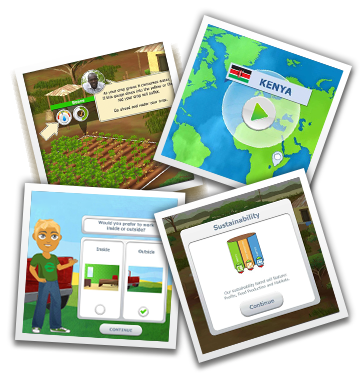
Play Now!
Multiple program options available. Choose the program option that best works for your class.
Nutrien / Nutrien Ag Solutions, is committed to educating the next generation about sustainable agriculture. By partnering with others, we support education programs that reach children around the world.
We believe that youth education programs should be based on science, align with curriculum and teach sustainable practices that result in long-term positive change.
We hope you enjoy the Journey 2050 program and look forward to hearing your thoughts.
Company Profile – Nutrien:
Nutrien is the world’s largest provider of crop inputs and services, playing a critical role in helping growers increase food production in a sustainable manner. We operate with a long-term view and are committed to working with our stakeholders as we address our economic, environmental and social priorities. With nearly 20,000 employees around the world, we are feeding the future.
Learn more about Nutrien here
Learn more about Nutrien Ag Solutions here

Nine provinces are currently at the table including British Columbia, Alberta, Saskatchewan, Manitoba, Ontario, New Brunswick, Nova Scotia, Prince Edward Island, and Newfoundland and Labrador. These member organizations are committed to a collective, cross Canadian effort and all have increased their teacher and student reach and effectiveness by being involved in the national organization.
AITC-C’s overall goal is to foster a greater understanding and appreciation of agriculture that will enhance interest in the sector’s capacity to be more productive, innovative and stronger. As evidenced by the combined reach of a million students and teachers across Canada, AITC-C member organizations have a substantial impact and influence on the attitudes of youth. Students and teachers involved with AITC-C programs and resources, have expanded the reach of agricultural education by sharing new knowledge with friends and families, and in the communities where they live.
Learn more here

Ag for Life is a not for profit organization dedicated to building a greater understanding and appreciation of agriculture and its fundamental connection to life.
It is their mission to help Albertans understand the incredible depth and opportunity that agriculture affords. Bringing together some of Alberta’s strongest corporations from various sectors including agri-services, energy, financial, not for profit along with farmers, ranchers and community leaders, Ag for Life is dedicated to delivering educational programming that will serve to improve rural and farm safety and build a genuine understanding and appreciation of the importance agriculture has on lives.
Through close collaboration with not for profits, community leaders and government, Ag for Life develops, expands and offers hands-on educational programming to children, youth and adults with the goal of closing the knowledge gap between rural and urban populations, strengthening the agriculture sector so that it is sustainable over the long term, greatly reducing the number of farm fatalities and injuries and elevating the fundamental importance of having a strong and sustainable food producing community.

Canola Oil: One dietary message for consumers has not changed in a decade: eat less fat. This advice aims to help millions of North Americans reduce their risk of overweight, obesity and diabetes. In recent years, a new message about fat has emerged – the type of fat in the diet is also important. Canola oil is the best blend of fats for good health.
Canola Biodiesel: The machines that power the Canadian economy – heavy equipment, long haul trucks, farm machinery, municipal fleets, generators – are powered by diesel fuel. Canola biodiesel is better for the environment than diesel. In almost every instance, biodiesel is the best alternative to help reduce greenhouse gas emissions and clean the air.
Vehicles currently burning diesel can easily make the switch to biodiesel today with no modification. This is about taking what we’re already doing and finding alternatives that are good for the environment, good for farmers and good for Canadians.
Canola Meal: Canola meal is one of the most widely used protein sources in animal feeds. It has an excellent amino acid profile and it’s rich in vitamins and essential minerals. It is palatable and non-toxic.
A process has been patented to create a 90% protein isolate that has excellent nutritional and functional characteristics for human consumption. Canola meal is also a high-quality organic fertilizer.
The Calgary Stampede contributes to the quality of life in Calgary and southern Alberta through our world-renowned 10-day Stampede, year-round facilities, western events and several youth and agriculture programs. Exemplifying the theme We’re Greatest Together; we are a volunteer-supported, not-for-profit community organization that preserves and promotes western heritage and values. All revenue is reinvested into Calgary Stampede programs and facilities.
One of the largest projects in the Stampede’s history, the Nutrien Western Event Centre is an ultra-modern showcase for western events, exhibition and sustainable agriculture education, unique in Western Canada. Designed to form a lasting connection between urban and rural communities, it hosts an engaging, globally-focused educational program called Journey 2050, and it plays a central role in making the Calgary Stampede a world-class, year-round gathering place. Opened in June of 2014, the Nutrien Western Event Centre is the new home for western events on Stampede Park, hosting national and international competitions, trade shows and exhibitions. The facility features a 250’x125′ ft. show floor in an arena that seats 2,500 guests plus VIP suites. An adjacent 20,000 sq. ft. multipurpose hall provides options as a show-ring or warm-up arena, stalling, tradeshows or concurrent events, and the building’s magnificent rotunda doubles as a grand entranceway and weekday classroom for the Journey 2050 program.
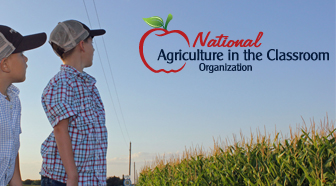
National Agriculture in the Classroom supports state and territory programs by providing a network that seeks to improve agricultural literacy — awareness, knowledge, and appreciation — among PreK-12 teachers and their students. Agriculture in the Classroom programs are implemented by state and territory-operated programs.
The mission of Agriculture in the Classroom is to “increase agricultural literacy through K-12 education.” An agriculturally literate person is defined as “one who understands and can communicate the source and value of agriculture as it affects quality of life.” Agriculture in the Classroom (AITC) programs seek to improve student achievement by applying authentic, agricultural-based content as the context to teach core curriculum concepts in science, social studies, language arts and nutrition. By encouraging teachers to embed agriculture into their classroom, AITC cultivates an understanding and appreciation of the food and fiber system that we all rely on every day. AITC is unique within the agricultural education community as the lead organization to serve the full spectrum of K-12 formal education. NAITC partners with organizations like Nutrien on programs such as Journey 2050 to leverage its resources to reach more teachers and students.
Learn more here
THANK YOU to the National Association of Agricultural Educators for helping spread the word about Journey 2050!
NAAE is a federation of state agricultural educators associations with more than 7,800 members. Their members are involved in school-based agricultural education at any level, from middle school through post-secondary, and state and national agricultural education leaders.
They advocate for agricultural education, provide professional development for agricultural educators, and work to recruit and retain agricultural educators in the profession. They offer a variety of programs and services to support this three-pronged mission.

The National FFA Organization is a national youth organization of 649,355 student members as part of 7,859 local FFA chapters in all 50 states, Puerto Rico and the U.S. Virgin Islands. The organization is supported by 225,891 alumni members in 1,934 local FFA Alumni chapters throughout the U.S. The FFA mission is to make a positive difference in the lives of students by developing their potential for premier leadership, personal growth and career success through agricultural education. The National FFA Organization operates under a federal charter granted by the 81st United States Congress and it is an integral part of public instruction in agriculture. The U.S. Department of Education provides leadership and helps set direction for FFA as a service to state and local agricultural education programs.
For more, visit the National FFA Organization online at FFA.org and on Facebook , Twitter and the official National FFA Organization blog

The Nutrients for Life Foundation aims to educate about the importance of responsible fertilizer use in growing healthy crops, increasing food production and feeding a growing population.
As a global organization, Nutrients for Life consists of members and collaborative partners that develop and distribute science-based materials to improve plant nutrient literacy, soil health knowledge and promotes fertilizer’s role in sustaining a growing population. All resources developed by Nutrients for Life are science-based and supported by agronomists, including those at the International Plant Nutrition Institute. The supplemental educational materials are based on the Foundation’s curriculum, Nourishing the Planet in the 21st Century, which has been reviewed by the Smithsonian Institution, the world’s largest museum complex and research organization.
Nutrients for Life is proud of their latest resource for high school teachers entitled Feeding the World; Protecting the Environment. Developed for use in advanced environmental science courses, students learn about essential plant nutrients, study the fertilizer-manufacturing processes, and examine the 4R Nutrient Stewardship framework. Additionally, students consider various federal regulations, such as the Clean Water Act, in relation to fertilizer-manufacturing. The spectrum of content, from production to stewardship on the farm, allows educators to share fertilizer’s impact in feeding the world.
The Journey 2050 program is a seamless partnership for Nutrients for Life and their mission.
Learn more here about NFL America Learn more about NFL Canada
The Royal Agricultural Winter Fair takes place every November in the City of Toronto. The Royal is the largest combined indoor agricultural fair and international equestrian competition in the world. It is where Canadian and international breeders, growers and exhibitors are declared champions and where hundreds of thousands of attendees come to learn, compete, shop and have a great time with friends and family.
Learn more here !

Thank You AdFarm for helping spread the word about Journey 2050 and Farmers 2050!
AdFarm is a full-service communications agency with award-winning expertise in agriculture and food PR and social media. Celebrating more than 30 years of business, AdFarm has built trusted relations with agriculture associations, media, key influencers and thought leaders; providing in-house strategic public relations counsel, creative, branding, and full suite digital services.
To learn more about AdFarm, please visit www.adfarmonline.com

The number one question students ask after finishing Journey 2050 is, ‘Can I play this game at home’ .
Journey 2050 was built as a school program . It is available in the iOS/Android/Windows store as a free download but it was intended for a classroom setting. There are timers to ensure students start and stop at the same time and there are only a few commodities included.
As a result, Farmers 2050 was created as a free farm game to play at home.
There is a twist to the new farm game!
Droughts occur, mortgage payments come due, and farm chores never stop.
Students have a chance to discover what it really takes to feed the world.
Players must plant crops, raise animals and craft goods to sell, while still managing the three pillars of sustainability: environmental, economic and social. Sound familiar!?
New additions to the game also include advice from local experts, such as an agronomist, veterinarian and mechanic. Plus, they can customize and decorate their farm to make it one of a kind.
Along the way, real farmers from around the world will show them what they are doing on their farms.
Farmers 2050 is FREE to play. There are no advertisements or in-app purchases.

Learn more at www.Farmers2050.com
Journey 2050 4+
Nutrien ltd..
- 5.0 • 2 Ratings
Screenshots
Description.
How will we sustainably feed 10 billion people by 2050? REAL FARM FAMILIES will guide you through your journey as you VIRTUALLY FARM in Kenya, India and Canada. The year 2050 is a key moment in time - the world's population is projected to be 2 billion more than today. Food production needs are expected to rise by at least 60% resulting in increased pressure on agricultural land, habitats and communities. Challenge yourself to grow crops sustainably while balancing the needs of social, economic and environmental factors. Remember, every decision you make impacts local and global sustainability. Agriculture’s ripple effect starts with the planting of a seed – you can create a ripple of your own through Journey 2050. Learn more at www.Journey2050.com
Version 2.0.0
Bug fixes and performance updates
Ratings and Reviews
App privacy.
The developer, Nutrien Ltd. , indicated that the app’s privacy practices may include handling of data as described below. For more information, see the developer’s privacy policy .
Data Not Linked to You
The following data may be collected but it is not linked to your identity:
- Contact Info
- User Content
- Identifiers
- Diagnostics
Privacy practices may vary, for example, based on the features you use or your age. Learn More
Information
- Developer Website
- App Support
- Privacy Policy
More By This Developer
Farmers 2050
Journey 2050 School Edition
Global Hero
Caution: you have javascript disabled. Your site experience may be affected.
publications & programs

How will we sustainable feed nearly 10 billion people by 2050? Journey 2050 takes students on a virtual simulation that explores world food sustainability. It is a free online program for Grades 7-12.
Using an inquiry-based approach the program encourages students to make decisions and adjust them as they see their impact on society, the environment and the economy at the local and global scale. The students experience the lives of three farm families in Kenya, India, and Canada.
As the student interacts with each family, they learn the role of the best management practices in feeding the world. Our Journey to feeding the world has started. Join us!
Explore Journey 2050!

- Seed Survivor
Journey 2050
- Caring for Our Watersheds
Little Green Thumbs
- Nutrients for Life – Canada
- Nutrients for Life – USA
- Progressive Agriculture Safety Days
- Farmers 2050
- Our Approach
- -- Seed Survivor
- -- Journey 2050
- -- Caring for Our Watersheds
- -- Little Green Thumbs
- -- Nutrients for Life – Canada
- -- Nutrients for Life – USA
- -- Progressive Agriculture Safety Days
- -- Farmers 2050
“How will we sustainably feed nearly 10 billion people by the year 2050?”
Journey 2050 allows schools to experience agriculture like it’s never been taught before. As grade 7-12+ students explore sustainable agriculture they make inquiry-based decisions to see the ripple effect on social, economic and environmental factors locally and globally. Farm families from Kenya, India and Canada guide students through interactive games such as a virtual farm simulation. Lesson plans are provided in this free, curriculum-based program.

- Curriculum-linked
- Free program
- Teacher written and reviewed
- Inquiry based
- Online resources available
- Suggested grade level: Grades 7-12
- Website: www.journey2050.com
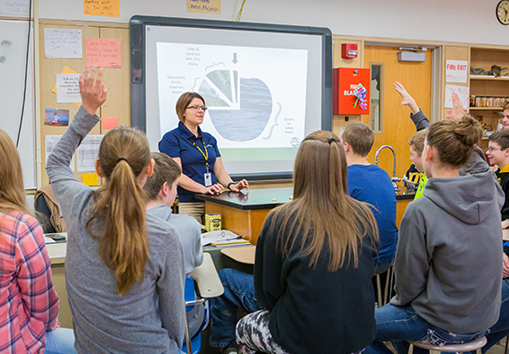
Active App Users
New teachers registered 2022, students participating in presentations, lifetime downloads, looking to contact someone about this program.

Recent Resources

ExploreSaskAg.ca

Garden Guide

Western Development Museum

- Journey 2050
How will we feed nearly 10 billion people?
Journey 2050 takes students on a virtual farm simulation that explores world food sustainability while learning from farmers across the globe!
Journey 2050 is a FREE agriculture education program that teaches students about different countries, careers and innovations that make agriculture one of the leading industries in the world.
Unlike any farming game you’ve ever played, Journey 2050 is based on real-life challenges and opportunities. Using an inquiry-based approach, this gamified, virtual program encourages students to make decisions and adjust them as they see their impact on the pillars of sustainability - social, environment, and economic - on a local and global scale.
Students can also independently download an app version of the game, Farmers 2050 , to play from anywhere in the world.
LEARN WITH JOURNEY 2050!
Journey 2050 was developed by teachers, industry experts and professional game developers.
It takes 7 hours to complete the program and links to curriculum between Grade 7-12.
In addition to the virtual farming app, interactive activities and hands-on lesson plans, AITC-C also offers direct connections through virtual visits, and field trips (at limited locations).
Journey 2050 Experiences

Online Program
Students from across Canada can take part in this experience through the Journey 2050 website and/or app store game. Everything is provided: from lesson plans to animated videos to interactive games!
This program is available for educators and parents across Canada.

Guest Speaker Program
Have an agriculture expert speak directly to your classroom! Guest Speakers deliver 2 hours of programming, and pass it off to teachers to lead their class through the rest of the Online Program.
This program is only available in select provinces.

Field Trip Program
This one-day field trip to the Nutrien Western Event Centre located at Calgary Stampede Park can accommodate up to two classrooms or 70 students per day.
This program is currently available in the surrounding area of Calgary, Alberta.
My students are having a great time with the Journey 2050 program. They are engaged and having fun. It is great to overhear the side conversations they have about the choices they are making. They celebrate their successes and lament their failures without recognizing that they are learning!
Discover how Journey 2050 fits into your curriculum!
Geared to Grades 7 to 9 students, see how components of the Journey 2050 program can fit a wide range of subjects and curriculums.
Students can take the experience home with Farmers 2050
Discover what it really takes to help feed the world with Farmers 2050.
Students can create and manage a sustainable farm of their very own. They will tend to crops, raise animals, and craft goods to trade, sell and donate in their local community, all the while managing the pillars of sustainability.

Thank you, Nutrien!
We are proud to partner with Nutrien to bring Journey 2050 and Farmers 2050 to educators and students.

Learn about our vision to bring agriculture to every classroom.
Provincial Members
Meet the 10 AITC-C provincial members across Canada.
Our Partners
Meet our valued partners and stakeholders.
Also in this section
- Advisory Committee

Explore a future career in agriculture and food with this career-finding tool.
I Am The Future
Visualize yourself in a career in agriculture with this interactive video creation tool.

Become a Partner
Help support our mission of agriculture literacy.
Become a champion of agriculture education. Donate today!
Discover opportunities to volunteer with AITC.
- Join Our Team

What's New
Keep up-to-date with AITC news.
Impact & Reports
Discover our impact and annual progress reports.
For the Media
Visit our media center to connect with us.

Curriculum Connected Resource Matrix
This is coming Fall 2021!
Business of Food
Coming October 2021

Mission Explorium
Unite your class in Mission Explorium and compete against teams across Canada.
Canadian Agriculture Literacy Month
Discover our flagship month-long celebration of ag literacy.
Great Canadian Farm Tour
Join classes across Canada for a memorable, interactive and engaging live virtual experience.
- Little Green Thumbs

Journey 2050

Explore agriculture around the world!
Journey 2050 is a program that combines curriculum and an interactive online game to teach students about food sustainability on a local and global scale. Lessons provide a background and are easily adaptable to virtual learning scenarios.
Check out the adapted elearning Journey 2050 lessons here!
Curriculum and Interactive Game
Interactive game.
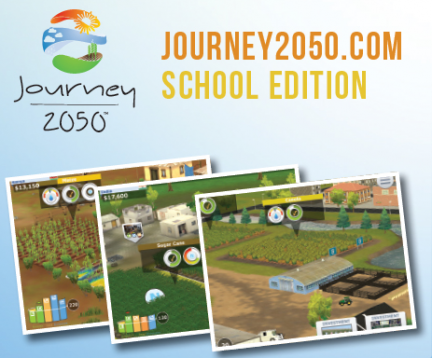
Lesson 1: Introduction to Sustainable Agriculture | Middle School Lesson | High School Lesson | Lesson 2: Plant Health | Middle School Lesson | High School Lesson |
Lesson 3: Water | Middle School Lesson | High School Lesson |
Lesson 4: Economy | Middle School Lesson | High School Lesson |
Lesson 5: Land Use | Middle School Lesson | High School Lesson |
Lesson 6: Careers for 2050 and Beyond! | Middle School Lesson | High School Lesson |
Lesson 7: Technology and Innovations | Middle School Lesson | High School Lesson |
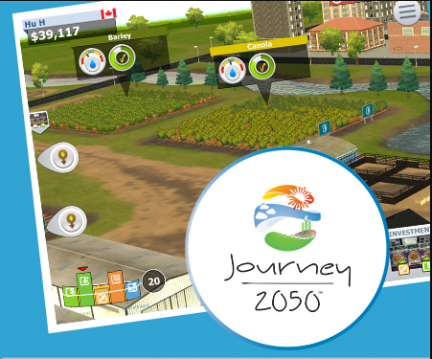
To play the game, visit: journey2050.com/play-the-game/
View a Compete Step-by-Step Teacher Guide to begin setting up your students.
A few notes about this game…..
- Student Reports are only available after completeing benchmarks within the game. Learn more about the reports!
- Reports take approximately 24 hours before they will show up on the Teacher’s Dashboard
- When students are working through these games, do not have them log out at the end of the each day . This will allow them to pick up right where they left off.

Get our latest news and events in your inbox
- Name * First Last
- Select a Newsletter Edition * Select a Newsletter Edition Primary Secondary Both Homeschool
- Comments This field is for validation purposes and should be left unchanged.
Follow Oregon Agriculture in the the Classroom
Agriculture in the Classroom is a nationwide educational program designed to help students develop an awareness and understanding that agriculture is the source of our food, clothing, shelter and other essentials. In Oregon, the program is a non-profit, 501 (c)(3) foundation. The College of Agricultural Sciences at Oregon State University (OSU) provides office space on the OSU campus.
- 200 Strand Agriculture Hall, Oregon State University, Corvallis
- 541.737.8629
- [email protected]

Journey 2050

Designed for: Grades 9-12 Learning Styles : Independent (student resource), Distance Learning Resource Type : External Link, Lesson Plan
Journey 2050 allows schools to experience agriculture like it’s never been taught before. As Grade 7-12 students explore sustainable agriculture, they make inquiry-based decisions to see the ripple effect on social, economic and environmental factors. Farm families across the world guide students through interactive games such as a virtual farm simulation and career avatar.
Privacy Overview

Building the dream: Vision 2050 and the Tanzania we want
Exploring Neuroscience, Psychiatry, & Rare Diseases, Bruce Leuchter, President & CEO, Neurvati Biotech 2050 Podcast
Synopsis: In this episode of Biotech 2050, host Alok Tayi, CEO and co-founder of Vibe Bio, speaks with Dr. Bruce Leuchter, President and CEO of Neurvati Neuroscience. They discuss capital markets, neurology, psychiatry, and Neurvati's work in ultra-rare diseases. Dr. Leuchter shares his journey from clinical training to leadership at Neurvati. The conversation covers the convergence of neurology and psychiatry, advanced technologies in drug development, and addressing unmet medical needs in neuroscience. Join us for insights into the future of biotech and developments in neuroscience. Biography: Dr. Bruce Leuchter brings deep-rooted, wide-ranging experience to his role as President and CEO at Neurvati, spanning neuroscience, clinical neuropsychiatry, biotechnology equity research, healthcare investment banking and entrepreneurship. His expertise captures all aspects of building and leading a neuroscience company, and his experiences have generated deep empathy for the patient journey. Across his many roles in the clinic, industry, and beyond, Dr. Leuchter has maintained a passion for knowledge and has aimed to purposefully apply that knowledge to help patients suffering from diseases of the brain and nervous system. A physician by training and neuropsychiatrist by specialty, Dr. Leuchter completed residency training in Neurology and Psychiatry at New York Presbyterian Hospital and Weill Cornell Medical College and is a Diplomate of the American Board of Psychiatry and Neurology. Dr. Leuchter served as Director of Clinical Neuropsychiatry at Weill Cornell Medical College and maintains a voluntary faculty appointment in the Department of Psychiatry. Dr. Leuchter has also held multiple financial services roles including biotechnology equity research at Goldman Sachs, healthcare investment banking at Credits Suisse, and biotechnology mergers and acquisitions at PJT Partners, all of which drive a nuanced understanding of the biotechnology industry and particularly the neuroscience ecosystem. Dr. Leuchter is Co-Founder and Founding Neuropsychiatrist of a digital therapeutics company, Click Therapeutics, which specializes in the treatment of neurological and psychiatric disorders. He serves as a member of the Scientific Advisory Committee for the Daedelus Fund for Innovation at Weill Cornell Medical College, as a member of the Life Science Institute Leadership Council at the University of Michigan, as a member of the Advisory Board at Michigan Drug Discovery, and as a Business Advisory Board member at FOXG1 Research Foundation.
- Episode Website
- More Episodes
- All rights reserved
Top Podcasts In Science
- Announcements
- Administrative Announcements
- Campus Activities
- Diversity, Equity and Inclusion
- International
- Interdisciplinarity
- Faculty and Staff
- Awards and Honors
- Professional Development
- Strategic Actions
- Strategic Planning
- Implementation Planning
- Digital Newsletter Archive
Can We Reach Green Goals by 2050? Yes, But It’s Complicated
Averting climate catastrophe and delivering a just world for our grandchildren hinges on collective decisions we make now.
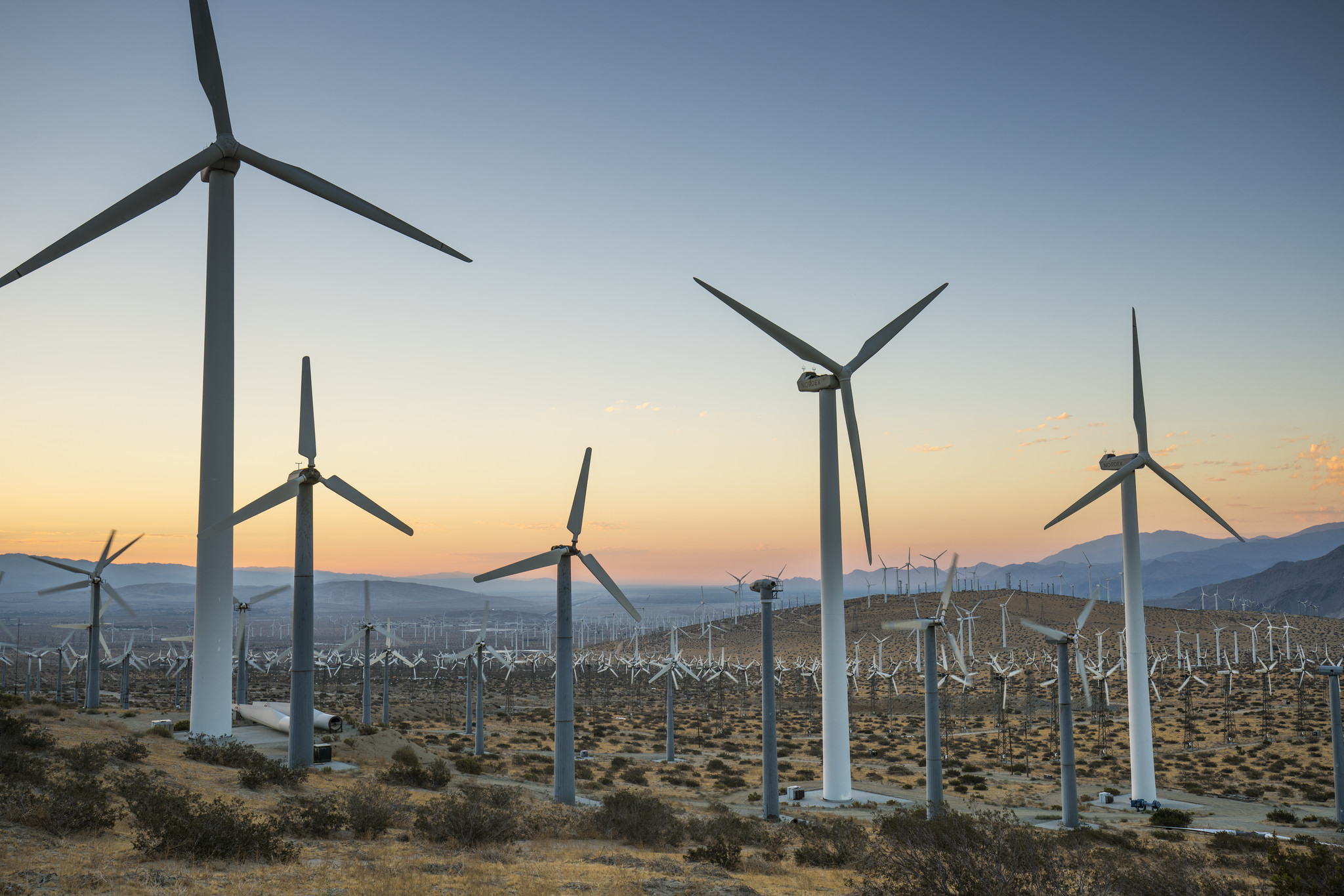
We’ll probably reach net zero carbon emissions by 2050, say engineer Jordan Kern and economist Harrison Fell . Or at least we’ll get close – especially when it comes to electricity.
In the future, green energy could leave zero carbon footprint. We could store it for years and transfer it from coast to coast, delivering energy at low cost to anyone who needs it. It’s possible, Kern and Fell said, when I spoke with the NC State researchers last November. It’s even likely. But it won’t be easy.
Kern models environmental risks, and Fell studies the economics of energy systems and policy. They shared what they know about what influences energy policies, how those policies play out in society, and why people behave the way they do. In our conversation, they laid out the challenges – and opportunities – that may arise on the journey to a green energy future.
What became clear is that a just energy future will require collectively making hard decisions, picking up slack, accepting responsibility and maintaining faith that what we do now will help future generations. It will also require a lot of money. Governments and individuals will decide where and when to spend this money. And our decisions along the path will fork off into a number of possible futures.
Whether everyone can participate during the transition and benefit in the future, depends on us: will we create incentives, policies and regulations that ensure no one is overlooked, left behind or abandoned? What will we do to avoid dystopian futures of gas deserts, economic collapse and dangerous blackouts? And what if it all goes right? Could energy be free, reliable and accessible for all? Far into the future, a peaceful, resourceful civilization unconstrained by energy is imaginable.
This interview, conducted as part of the Long View Project , was edited for clarity.
Agreeing to pay for inherited problems
From what you’ve discovered in your work on energy policy and modeling, what are some of the largest threats to the energy transition?
Jordan Kern : If you put yourself in the shoes of lawmakers, I tend to think it boils down to a couple of simple things – the willingness of people to pay for a system that is cleaner and equally reliable. I think that’s feasible. We have to collectively decide to do that – and to pay for it.
Harrison Fell: We’re talking about a global public good with damages that are largely in the future, though increasingly becoming more in the present. Some of the catastrophic things, like two feet of sea level rise, are not going to happen next year, but they could happen in 30 or 40 years. I can freeride off of anybody, any nation’s, anybody in the world’s contribution to this public good, and the biggest damages that I’m avoiding are probably decades into the future. Getting everybody to agree to pay, to do something, is the crux of the solution. This is why it’s so challenging.
Kern: Something similar to that is this generational wealth transfer problem. If you’re young now, that problem has been put on you by previous generations accumulating carbon dioxide in the atmosphere. You’ve inherited this problem that you haven’t really contributed to as much. Now you’re being asked to make a sacrifice that may not directly benefit you, but rather, someone in the future who you may not connect to.
You’re being asked to make a sacrifice that may not directly benefit you, but rather, someone in the future who you may not connect to.
Fell : That generational challenge plays out in an international context as well. The analogy is similar to a developing country saying: Why do I have to pay? Why do I have to develop energy in a clean way while Western Europe, the U.S., China and other places have developed in a way that is more environmentally harmful?
The International Panel on Climate Change pretty much says we have to do that – make this collective agreement and reach net zero by 2050 – to stave off the biggest future climate catastrophes. How likely are we to reach this agreement?
Fell: As economists, we want to create policies or market mechanisms that provide incentives to do things to meet environmental objectives, in this case to meet zero-emission targets. We’re often thinking about how sensitive consumers are to the price of vehicles when they choose to buy a gas-powered versus an EV. How sensitive they are to electricity prices when they decide whether or not to put in a more efficient heat pump versus a standard HVAC system. These are all very much what we’re considering when we when we think about: how consumers and people in industry act, given the incentives they have now, and then; how they will act if we tweak those prices, via some policy subsidies, taxes, whatever it is.
So people may be more willing to pay for the future if there’s some kind of economic incentive right now. So given how you think people will react to our current policies, how close do we come to Biden’s target of carbon neutrality by 2050?
Kern: I don’t know. It’s state by state. I think the story in the U.S. is that there is no real federal energy policy.
Fell: There is the Inflation Reduction Act.
Kern : There are incentives. There are carrots for doing the right things.
Fell : Carrots only.
Kern : Yeah, and no stick.
Fell : No sticks.
Kern : The last 20 years has been about some states pushing aggressively for reduced or lower emissions, aiming ultimately for zero emissions, at least on the electricity side. I think, again, there’s wealth transfer, or at least, cross-subsidization. The states that adopted early paid a steep penalty for adopting technologies early, and everybody else has benefited from that. In the US, I tend to think that getting a mostly zero-carbon electricity system is a foregone conclusion. I think by 2050 that’s very likely, with maybe a few holdouts. But I also think it’s important to maybe relax the expectation that we get to 100. If we get to 87 – that’s pretty good, right? And I feel more confident that we’ll get there. The electricity sector is by far the easiest one to decarbonize. There are only a few smokestacks to replace.
In the US, I tend to think that getting a mostly zero carbon electricity system is a foregone conclusion. … The electricity sector is by far the easiest one to decarbonize.
With vehicles, it’s difficult. With agriculture and land use change, it’s difficult. Industry, it’s difficult. This is the foundational piece of what has to happen. It’s moving in the right direction, but is it going to happen fast enough or widely enough, globally? The rate and the scale at which this has to happen is daunting.
Fell : Yeah. Look at a lot of the analyses of the Inflation Reduction Act, the CBO [Congressional Budget Office] estimates there’s roughly $700 billion in climate-related, energy-related subsidies in that bill. If you look at the analysis of that by the Princeton Group, by Rhodium, all these other big energy system modelers, I think we still fall short of net zero by 2050. Forty-some percent reductions by 2035 on some of these. Even under that pretty massive investment – certainly the biggest investment the US has ever made at the federal level towards climate policy – we’re still not quite there.
Winners and losers
Kern : I’m fascinated by the idea that we’re caught in this situation where if we move too slow, we’re screwed. If we move way too fast, we’re screwed. And so we’re in this situation where even if there’s good technology that’s dirt cheap, a penalty will still be paid. Politically you see this playing out. In presidential debates, for example, say they’re talking about somebody wanting to ban oil and gas drilling or fracking. They tie it to jobs and livelihoods. There are going to be winners and losers.
Kern : A lot of the fossil fuel assets, like coal-fired power plants, have already been built, and so the question is: Let’s say something cheaper comes along. You still borrowed billions of dollars to pay for this infrastructure that relies on fossil fuels. There’s a cost to switching early and stranding your asset. How big of an issue is that?
Fell : Well, obviously it’s different in different parts of the country because we have different electricity markets and different ways we incentivize building electricity assets. So in the market-based regions, you’re just out of luck. I mean, if you built a gas-powered power plant in Texas, and wind and solar get amazingly cheap (they already are in Texas), you’re just going to get undercut, and you’re out. That’s on you, the investor who put your money in.
Now, if you’re in North Carolina – Duke Energy controls our electricity sector for the most part – it’s a different story. They’re paid on a rate-of-return basis. So they build capacity, and they get a guaranteed rate of return on investment in those capacities. They have incentives to keep some of that capacity around, to keep some of those gas or coal plants. They also have incentives to build new stuff because they also get rates of return on the new stuff.
Kern : If the progressive environmental, climate hawk-type argument prevailed, and we sped the transition up rapidly, do you feel like there is any broader systemic, financial or economic risk associated with globally stranding fossil fuel assets?
The speculation that I’ve read about is that let’s say there’s a group of fossil fuel assets that are out-competed. We decide, through government action, or through the market, that they’re too expensive. So they’re no longer successful, but that happens so quickly, that they’re unable to pay back who they owe money to, and then those people are unable to pay back money to who they owe money to. And that’s a financial crisis, right? The comparison that many make is to the 2008 financial crisis. The response there was ultimately a public bailout of large financial institutions who were deemed to be too big to fail.
So would we bail out fossil fuel companies?
Kern: The implication there is that if the large financial institutions failed, it would cause such a profound negative social impact that it was viewed as a public service to just either lend or give the financial institutions money.
I guess the question I’m getting at is: Is fixing climate change quickly [by lowering carbon emissions] too much of a self-inflicted wound that people will just decide we can’t move that fast?
Fell : I’m less concerned about some cascading financial collapse à la the housing market collapse.
Kern: Good.
Fell : It was super sudden – and the entire country has houses. It touched us all. Really bad bets were made by a lot of big financial institutions.
Can you expand on why you’re not concerned about an energy market crash?
Fell : Well, one, the pace at which this has to occur would have to be really dramatic. I mean, we’d have to see some massive drops in prices. Two, a lot of our energy companies are somewhat diversified. There are independent power producers who own a coal plant or something like that. Calpine, NextEra, some of these other big energy companies, they own a variety of assets, gas plants, coal plants, maybe even hydro plants, maybe even wind and solar. So they’re a little bit more diversified. And then, three, we just don’t have thousands and thousands of plants, period – let alone the ones that are going to fail.
We’ve kind of seen some of this already. When we learned how to do fracking really well, natural gas prices fell, and electricity prices fell a lot with the gas prices. All of a sudden, all this coal that we had is not nearly as profitable as it used to be – even nuclear is not nearly as profitable as it used to be. We’ve seen a lot of retirements in coal because it’s just not economically competitive with gas plants. Combine that with an increase in wind and solar, and then coal is really not competitive because we now have a lot of low-cost generation on the system. We’re seeing year over year, continual retirement of capital in the coal sector – and that hasn’t led to any significant financial collapse in our energy sector.
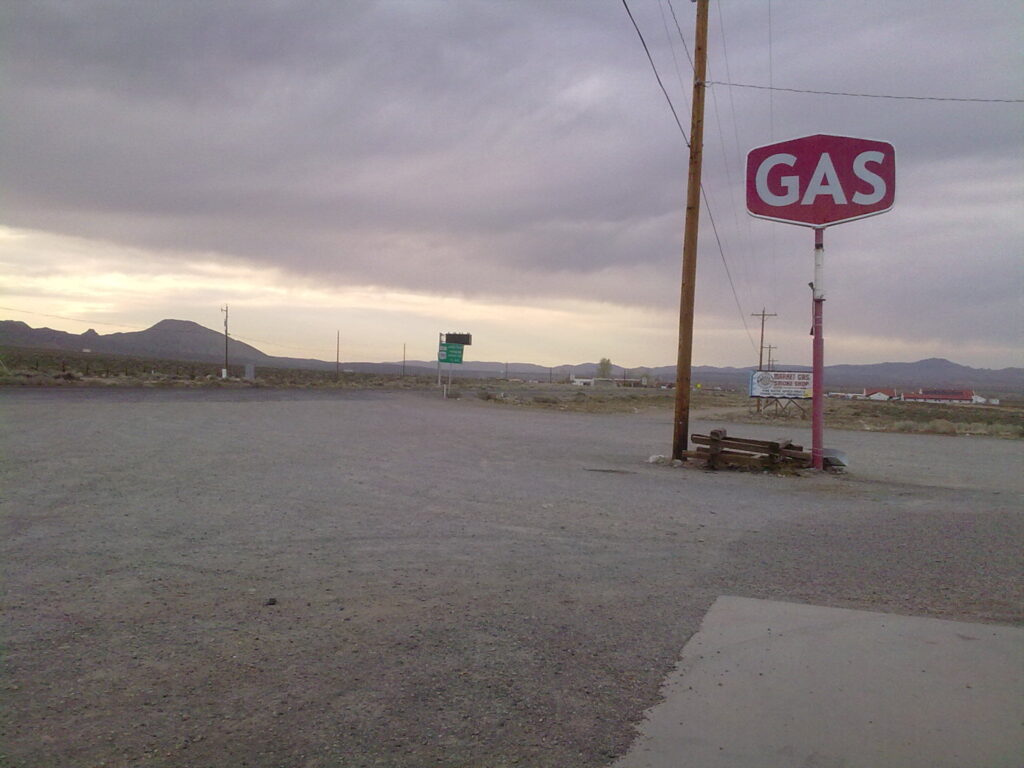
Kern : No. But coal companies have gone bankrupt. And regionally, that’s big. I tend to agree with you that the risk of a larger, cascading issue is not that big. But it’s going to pop up in certain areas.
In politics.
Kern : I think the politics part of it is huge. The volatility part of it could be more concerning. Think about the oil and gas sector. One of the pinch points we’ve been seeing recently is refining capacity. We’ve dramatically reduced refining capacity, and there are not great incentives to go invest in refining capacities. The margins tend to be relatively small, and the long-run forecast for demand growth in oil and gas is not big. In fact, it’s probably leveling off to shrinking if you go way out in the future. You don’t have a lot of people who want to invest in these things.
They’re extremely critical for the price we end up paying at the pump. If a refinery goes down somewhere, if we have a refining outage, we’ll see that at the pump. Over time, as you retire a few more of those, you’ll start to see a lot more of this volatility and some of these issues with spikes and gas prices and stuff. You know, $6, $7 gasoline prices would scare the pants off of most politicians. I think those types of outcomes will become more likely as we move along this transition path. I think the volatility is going to be massive.
Fell : And somewhat self-correcting, right? Because if people experience $8 or $7 per gallon gas, the first thing they’re going to do is try to get an electric vehicle, right? So it’s this gradual unwinding.
Kern : My concern is that we lose political will along the way. So somebody says, oh, geez, we’re at $8 gas prices , and refining companies are saying we can’t invest in this. There’s just no money to be made if we keep investing in these things . Then the government takes some sort of movement to emergency, to keep them going, which effectively keeps internal combustion engines going on the road and cascades and sort of defeats our purpose of trying to decarbonize.
But those decisions would depend on who is in charge, right? In England, for example, they’ve pretty much phased out coal by making it just too expensive. And the government didn’t bail them out.
Fell : No, but they didn’t also see a concurrent, massive spike in electricity prices. The whole European energy crisis over the last couple of years, they’ve seen some really extreme prices, partly due to Russia’s invasion of Ukraine. But some of this started before Russia invaded Ukraine. They were already seeing these big spikes because of some really hot summers and some gas shortages and underperforming renewable energy and a few things cascaded that lead to these very high prices. But if they started to shut down a bunch of coal plants, and then all of a sudden electricity prices doubled or tripled, I’m sure there would have been massive objections. Certainly, we would see that here. I think electricity is more buffered against this than transportation because we have a bunch of other sources that are already cheaper than coal in most places, even natural gas in some places. So we’ve already got this low-cost alternative.
But the transition path in the transportation sector is going to be a little more volatile. Right now it is largely gas versus EV. There’s no sort of in between. I mean, obviously, you can get a hybrid or something more efficient, but we’re largely subsidizing switching to EVs. We’re going to have these weird tipping points. Some of those assets [like oil refineries]: We’re going to get fewer and fewer of them. Our refining capacity is going to get harder. Maybe you can imagine a world in which gas stations become harder to find. The whole distribution network of the oil and gas sector relies on being able to sell a bunch, a bunch, a bunch of gasoline. And when we start to do less of that, there’s going to be less investment in that. All that sort of stuff opens the door for very big price spikes, and nobody wants a spike.
Leaving behind fossil fuels, without abandoning certain communities
Kern: And this is where it’d be good [to look more into equity concerns]. Because right now, to opt out of the price spikes, to buy [an electric vehicle] is a bit more expensive.
Yeah. It’s a privilege.
Kern : Yeah, it is, right? There’s a lot of data showing that EV ownership specifically, less so solar, skews older, more affluent white guys. It won’t be a nice, neat transition. I think part of the volatility will be: What happens when you still drive a gasoline car but you’re in a gasoline or gas station desert? Or you can’t find one, or you can’t find one in an emergency when you really need one? That sort of stuff is going to shake out in ways that are worth thinking about. And it is probably difficult to anticipate.
If we were to replace all fossil-fuel engine cars with EVs, does that impact the grid a lot?
Kern : Oh, a ton.
So what do we do to prepare for that?
Kern : The absolute best way to break the grid right now is to electrify all vehicles. It’s a gradual process. And it’s not just vehicles, it’s heat pumps. If we’re gradually electrifying our energy consumption, utilities have to be on it. They have to anticipate how demands are going to change in very specific ways, multiple years in advance, and then build the right stuff to respond to that. At least anecdotally, I think they’ve struggled.
Duke Energy, our main utility in the state, last winter, for the first time in recent memory, they ran out of electricity, and everyone was pissed just because it was the holidays. [On December 24, 2022, Duke Energy issued rolling blackouts for the first time in North Carolina state history in order to protect the grid during soaring demand during a winter storm.] I think if it had happened any other day, it wouldn’t have been a big deal, but everybody’s family was over. Part of that was, at least they said, a difficulty in forecasting demand. They had some mechanical failures with some of their power plants. I think utilities are going to be surprised by how much electricity people are using in an instant. And if that gets really high, or goes higher than what they expect, that’s when reliability issues can pop up – and those also don’t affect everybody equally.
Fell : This is what makes this such a great social science and engineering problem. We have to design a system from an engineering perspective that’s super adaptable, and it has redundancies and transmissions built in the right way, and, you know, all of the components that we need to physically build a grid. And then on the other side of that, we have to think about the incentives that consumers have, and the Dukes, the utilities of the world, have to build all that stuff. Then, on the consumer end again, to consume it at the right time, to install the right types of products, install the efficiency products, the conservation products, smart home technologies that allow your refrigerator to talk to the grid and know if it should be cycling or pulling power.
We’ve got to build the machine. We’ve got to get the people to do the right things. And then we’ve got to make sure we don’t hurt anybody in the path, at least not too much.
What are the incentives for people to adopt those technologies? What are the incentives for people to use energy in ways that align with the reliability and resiliency goals of the electricity balancing area? I mean, these are all very much intertwined with the physical stuff we have to build too.
And then, layering on top of all that stuff, we want to do all of this in a way that’s equitable, in a way that hopefully reverses some historic environmental injustices, that doesn’t leave behind communities traditionally reliant on fossil fuel industries. There are a lot of things we have to do. We’ve got to build the machine. We’ve got to get the people to do the right things. And then we’ve got to make sure we don’t hurt anybody in the path, at least not too much.
Storage and transmission from coast to coast
Fell : The area that I’m most concerned about is whether or not we can figure out how to do electricity transmission. Without dramatically expanding our electricity transmission and upgrading our electricity grid, we’re not going to be able to unlock all of this renewable energy potential that we have and all the spending that we’re going to do on renewable energy. That’s the cornerstone of a zero emissions electricity sector – and that’s really the cornerstone of decarbonizing our entire economy.
We know the technologies to decarbonize the electricity sector – solar, wind, battery technologies, maybe some green hydrogen, maybe some geothermal, things like that – but then we have to get all that new power to all the people. And then we have to get all those people to convert everything that wasn’t using electricity as its primary energy source. It’s a big, big challenge. I think we’re going to be a little bit short. The other part of this is that a lot of these models are what we call “knife-edge” solutions.
That means that if costs fall on this technology, just enough given the subsidies, we’re going to invest a lot in it and use it. We don’t know what the cost of solar or wind or batteries or hydrogen is going to be in 10,15 years. If it happens to fall a little bit lower than some of these models have predicted, then we could see even bigger, quicker transitions.
The opposite end of that is also true. Say something gets more expensive. Borrowing money gets more expensive. Labor gets more expensive. Material gets more expensive. Well, now even with the $30, $40, $50 megawatt hour subsidy, maybe it doesn’t make sense.
Say the knife cuts the right way and we’re able to capture green energy at reasonable prices. Are we capable of storing and transmitting that energy? Because basically, we just have to save it up and have it around for when people need it, right?
Fell: If I could boil down to the single biggest challenge we have to decarbonize our electricity sector, which again, is the cornerstone for decarbonizing our entire economy, it’s transmission. Transmission and storage. Our system of how we set up electricity in the US was not designed to generate power in Iowa and sell it in North Carolina. But that’s precisely what we’re going to need to do to decarbonize quickly. We’ve got to have lines crisscrossing the country. We’ve got to have storage possibilities that allow us to do not just intra-day but inter-year moving of power. We need to be able to get sun from Arizona to the middle of the country and from the middle of the country to the East Coast. All of that relies on good storage and transmission, and we do not have the institutions to do that at this stage.
Kern : It’s not just institutions. There are lots of individuals. Building high-voltage transmission from Iowa to North Carolina means you’re crossing jurisdictions of hundreds, thousands of cities, multiple states, different electric utilities and a ton of private property.
Along that path, anybody who decides to derail it has an outsized ability to do that. There’s a lot of opposition culturally. It’s become very politicized: climate change and energy. What you’re saying is you’re going to extract wind from flyover states that are largely red and export that electricity to coastal elite, liberal cities. The optics are very difficult.
Fell : Extremely, extremely difficult. That’s why I think this is the biggest challenge – and I’m not just speculating. If you look at, say, Jesse Jenkins at Princeton’s analysis of the Inflation Reduction Act, his big ticket number, 40% reduction in emissions by 2035, that was the key number of his analysis. And then he comes out a few weeks later and says, oh, by the way, you only get that 40% reduction if you basically triple the rate of transmission expansion over that time period.
Kern : Which is the single hardest thing to do.
Our system of how we set up electricity in the US was not designed to be generating power in Iowa and selling it in North Carolina. But that’s precisely what we’re going to need to do to decarbonize quickly.
Does he give suggestions for how to triple the transmission rate?
Fell : There are a lot of people looking into this, a ton. One of the things that is probably pretty clear is that we’re going to have to cede a little bit more power to a federal regulator – FERC [Federal Energy Regulatory Commission], likely, DOE [Department of Energy], maybe, to be able to prioritize specific lines – a line from the middle of the country to the east coast, a line from the southwest to population centers in the west coast, something like that – and then also grease the wheels across all of these states and jurisdictions that these lines are going to have to cross. That’s not simple. It’s not like Congress can wave a wand and say “okay” all of a sudden. I don’t think they will be able to just magically pass a bill that says, “Okay, FERC can decide we can build any line anywhere across the country.”
Kern : Oh, yeah. Because then they’d have to let them do that for natural gas and oil pipelines.
Would building these power lines be messy like building a gas pipeline?
Kern : There are fewer environmental impacts. But not no environmental impacts. It’s a lot of no one wants to live near a high voltage transmission line. You piss a bunch of people off, basically.
Fell : Yeah, it’s, uh, I don’t have the solution. Federal regulators will have to come in and say, I’m sorry, Missouri and Louisiana and Arkansas, and anybody else in the middle who’s going to get a power line through you, we have to build this power line, or we’re never going to decarbonize. And maybe you pay them something, maybe you –
Kern : You’d have to.
Fell : Yeah, exactly. You’ve got to think about remuneration, compensation type of schemes to do this. It’s not going to be cheap. It’s not going to be easy.
Kern : Sometimes I think about that sort of stuff, and then I’m like, well, what if I were in a town hall meeting in Iowa or Louisiana? Would I feel comfortable saying that? I for sure wouldn’t. There’s the academic argument, and then it’s like, man, I don’t know.
Fell: I think you could if you’re Iowa, because you’re going to profit a lot by building transmission lines. Who I’m worried about are the Missouris, the Tennessees, the Indianas, the thoroughfare, because you’re not producing the power.
And this isn’t just a flyover state issue. This issue is coming up with offshore wind. There’s a lot of opposition, not only to the offshore wind infrastructure itself, like building the big turbines, but also building the power lines to connect those big turbines.
Are they going to be underwater?
Fell : They will, but at some point, they have to go through towns. And those are extremely wealthy towns. New York State auctioned off a record amount of offshore wind leases. Well, where the rubber is going to really hit the road is when they have to start building a transmission line through the Hamptons to get that power over to New York City. There’s going to be massive opposition. There already has been massive opposition to these things.
Kern : And the costs are really high.
Say we get past the costs and opposition to transmission. How are we doing with storage? Will we even have energy to transmit?
Kern : There are different ways you can store electricity. You could store it in a battery. You can use it to create something that carries energy like hydrogen. You can use electricity to essentially split water into oxygen and hydrogen. And hydrogen, you can use it in another type of mechanism, like a fuel cell, to produce electricity. It kind of works like a battery. Or there’s other sorts of energy storage, right? There’s compressed air.
Fell : Pump hydro is the largest.
Kern : Yeah, so there’s mechanical energy storage, where you pump water upstream. When you don’t need electricity, you use electricity to pump it up. And then when you do need electricity, you let it fall downhill to produce electricity.
I think that the storage stuff has largely been solved for how things fluctuate within 24 hours. But, what do you do if there’s four or five cloudy days in a row, or a wind drought or something? Longer duration, daily to weekly, or even seasonal storage: That would balance out the variability. That’s where transmission essentially becomes huge.
The advantage you can get from transmission is that the wind might not be blowing here, but 1,000 miles away, it might be. And if you average over a large space, a lot of that volatility smooths out. But that would not just involve incredible changes in infrastructure. Institutionally, you would have to evolve the way that utilities cooperate with each other and plan. It’s possible. It definitely is possible. The physical grid is there. You just have to invest more in it and change the way you do business a little bit.
Electricity anywhere, anytime
Kern: But that’s not the only way to decarbonize the grid. That’s the first generation. The part of climate change that is really intractable is the time constraint. You can’t solve the problem gradually over 60 years. The first generation of technologies that we use to decarbonize the grid – and hopefully, more broadly, the US economy – are not what we’re going to use 30 years later. There will probably be a continued evolution in low-carbon energy technologies that might include more advanced types of nuclear power, which look too expensive to fit into this first 30 or 40 years. But down the line, there are some critical issues with solar and wind. These are mostly related to intermittency – if all your electricity relies on the sun and wind, you have to always have sun and wind, which simply isn’t available everywhere, all the time. We don’t sweat these issues as much right now because we have a lot of other resources like natural gas we can use as backup. But we’ll encounter these issues more often as we scale up renewables.
And there are larger questions. If you choose the sub-optimal, from a technological standpoint, like wind and solar, well they’re cheap, but difficult to control. To deal with the variability of wind and solar, you have to build infrastructure for storage, transmission and extra generation capacity. When you just look at the sticker price of wind and solar and compare it to something like nuclear power, you kind of forget about those hidden costs.
But say it gets easier and cheaper to do solar and wind: Does it then make it just totally unattractive 50 years from now to invest in nuclear? There’s some path dependency where if you make one choice today, it kind of constrains the choices you could make in the future. I think our grandkids are probably going to live technologically in a very different world, I would guess, from an energy perspective.
Can you paint that picture for me? How do you see it?
Our grandkids are probably going to live technologically in a very different world, I would guess, from an energy perspective.
Kern : I think there’s a realistic future where electricity is not scarce at all, and it’s incredibly inexpensive, right? I think that is probably the logical endpoint. Materials and engineering gets so good that, like –
Fell : We’re making it everywhere for everything.
Kern : And it’s just – you never worry about it. Electricity is so cheap that we’re no longer really energy-constrained as a civilization. I think that opens up a lot of interesting possibilities.
Kern : Well, like, potential for greater economic equity, hopefully. But then, you know, like – just make whatever you want. You can shoot stuff into space –
Fell : It would massively change geopolitical relationships across the world. Certainly, it could have implications for closing wealth gaps. I do think that we’re quite a ways off. It’s sort of this big given that we have to do this pretty quickly. We’re still going to have to build big renewable facilities, big wind, big solar, maybe some nuclear, and then we have to figure out a way to get it there.
Say you get in a time machine, and it doesn’t take you to a specific year. It carries you to your most ideal future. Here, policy and politics don’t matter, and the grid, electricity, energy – they’re all optimized. How do you envision this moment?
Kern : I will say the grid does already work very well. It’s 99.95% reliable.
Fell: Fewer than five hours of outages, on average a year, for any given person. And it’s pretty affordable. That has a lot to do with the way we’ve regulated it, how easy it is for utilities to borrow money, and all sorts of incentives for utilities to build enough infrastructure.
Are policies, regulations and incentives what make the difference between a reliable grid like ours and a grid that’s always failing, like in developing countries where outages are more frequent? Or is it more of a technical thing?
Kern : I think, historically in the United States, it’s the ability of institutions and people to pay for the infrastructure. All the money comes from us. All of it. We are all ratepayers that pay utilities to perform a service. They raise money, and then they give money to other people to build the infrastructure. Then all the money to pay for the stuff they build and to pay for the people that operate the grid comes directly from the people who are consuming electricity. So if you have people who are willing to pay for that critical infrastructure, it gets built. I think that’s the difference. Countries with big, centrally-controlled power systems historically were wealthier countries that could afford that.
Fell : Yeah, you have a tax base or a rate base to do it [people paying taxes that go towards utilities or paying for utilities directly]. Obviously, if you’re in a developing country, and you don’t have a tax base, it’s going to be very hard to build a multibillion-dollar nuclear power plant or dam or something like that.
Also, as we think about this global public good issue – CO2 emissions mitigation/reduction – we have to think about those developing countries and how we can finance them to make decisions, invest in technologies that globally get us to our emission reduction goals. Because, again, our damages are not localized from our CO2 emissions. It doesn’t matter if the emissions come from Kansas or Kazakhstan, they’re going to have the same impact on climate change. We have to make sure everybody, all nations, all parts of the world, start to decarbonize, and we have to find ways to pay for that.
About the interviewees
Harrison Fell is an associate professor in the Department of Agricultural and Resource Economics. His research focuses on environmental, energy and natural resources economics, with an emphasis on policy-relevant work. Dr. Fell’s recent work is related to energy systems with a focus on renewable energy, emissions trading systems and electricity regulation.
Insider recommendation: Fell recommends you take a look at The Big Switch , a podcast where Melissa Lott of Columbia Climate School covers rebuilding energy systems from a layperson’s perspective. Economics nerds can check out the Haas School of Business Energy Institute’s blog , which is basically the reading list for Fell’s undergrad energy economics classes.
Jordan Kern does research focusing on stochastic modeling of coupled natural-human systems to 1) improve understanding of emergent risks to people and the environment across sectors and scales and 2) develop novel approaches for mitigating these vulnerabilities.
Insider recommendation: Kern recommends you take a look at The Energy Gang , a bi-weekly podcast about energy, clean tech and the environment.
- Campus Activities and Initiatives
- Long View Project
More From Executive Vice Chancellor and Provost
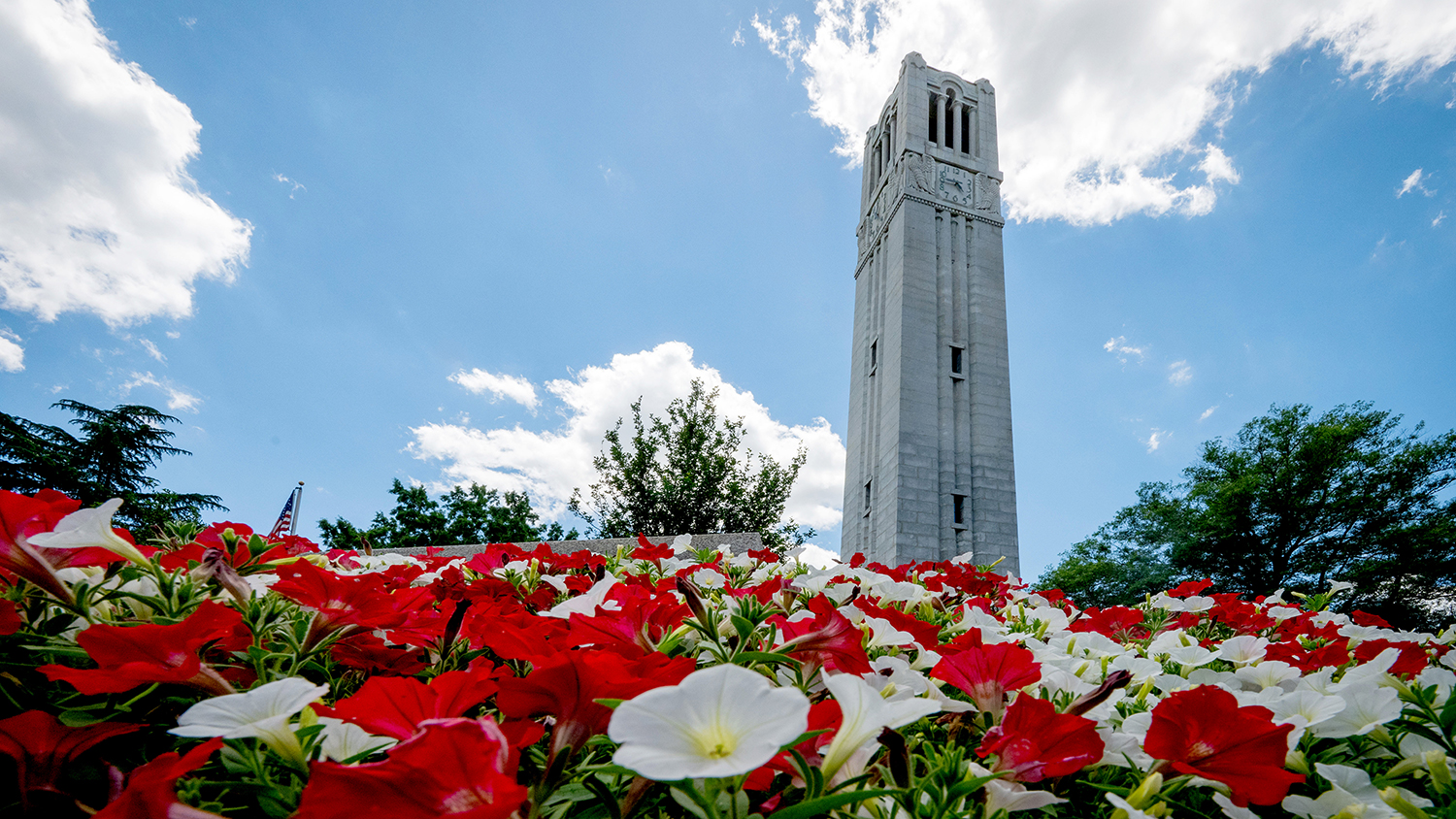
Jeff Yoder Named Professor of Biological Sciences and Executive Director of Genetics and Genomics Academy
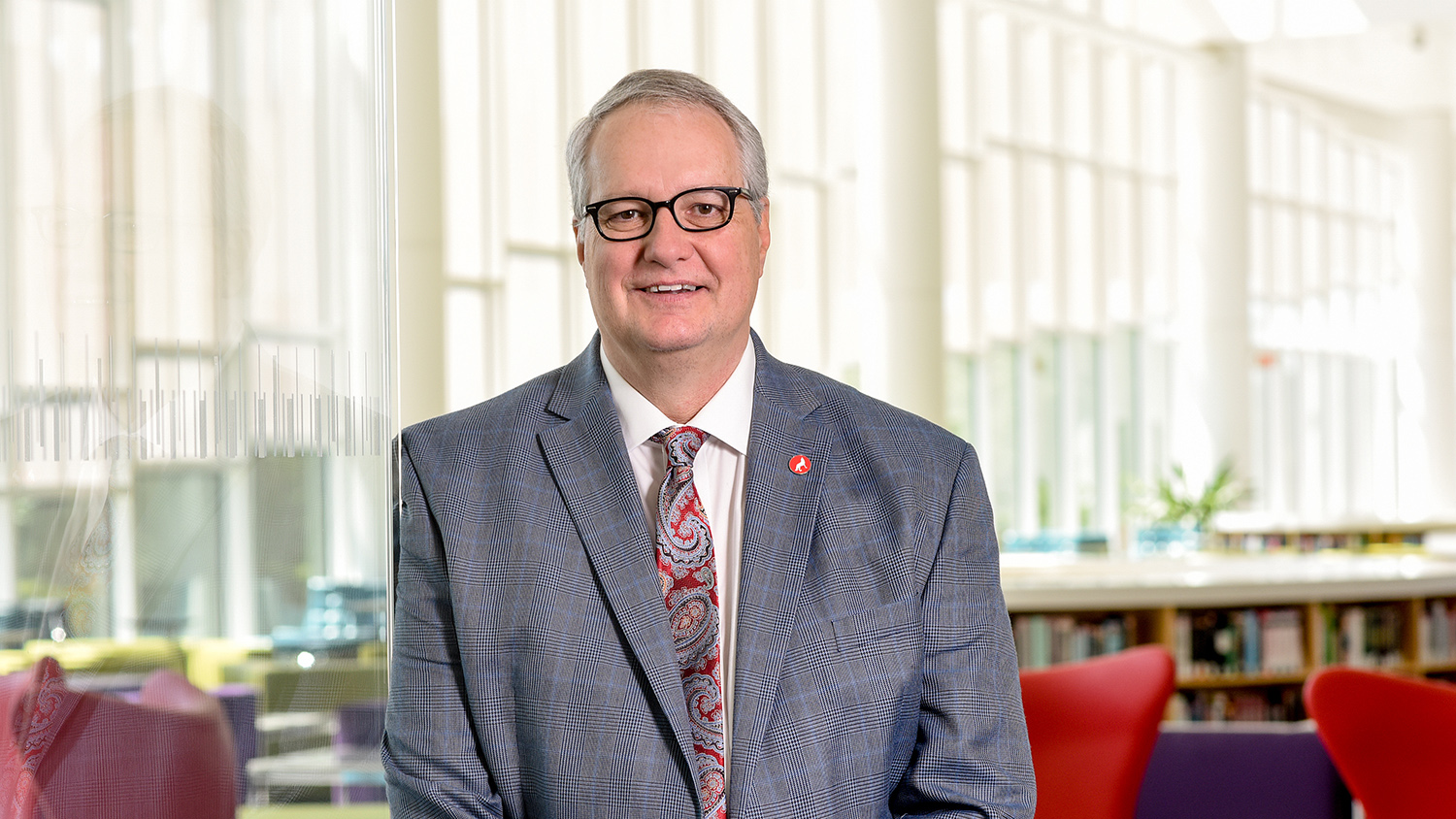
June 2024 Provost's Corner
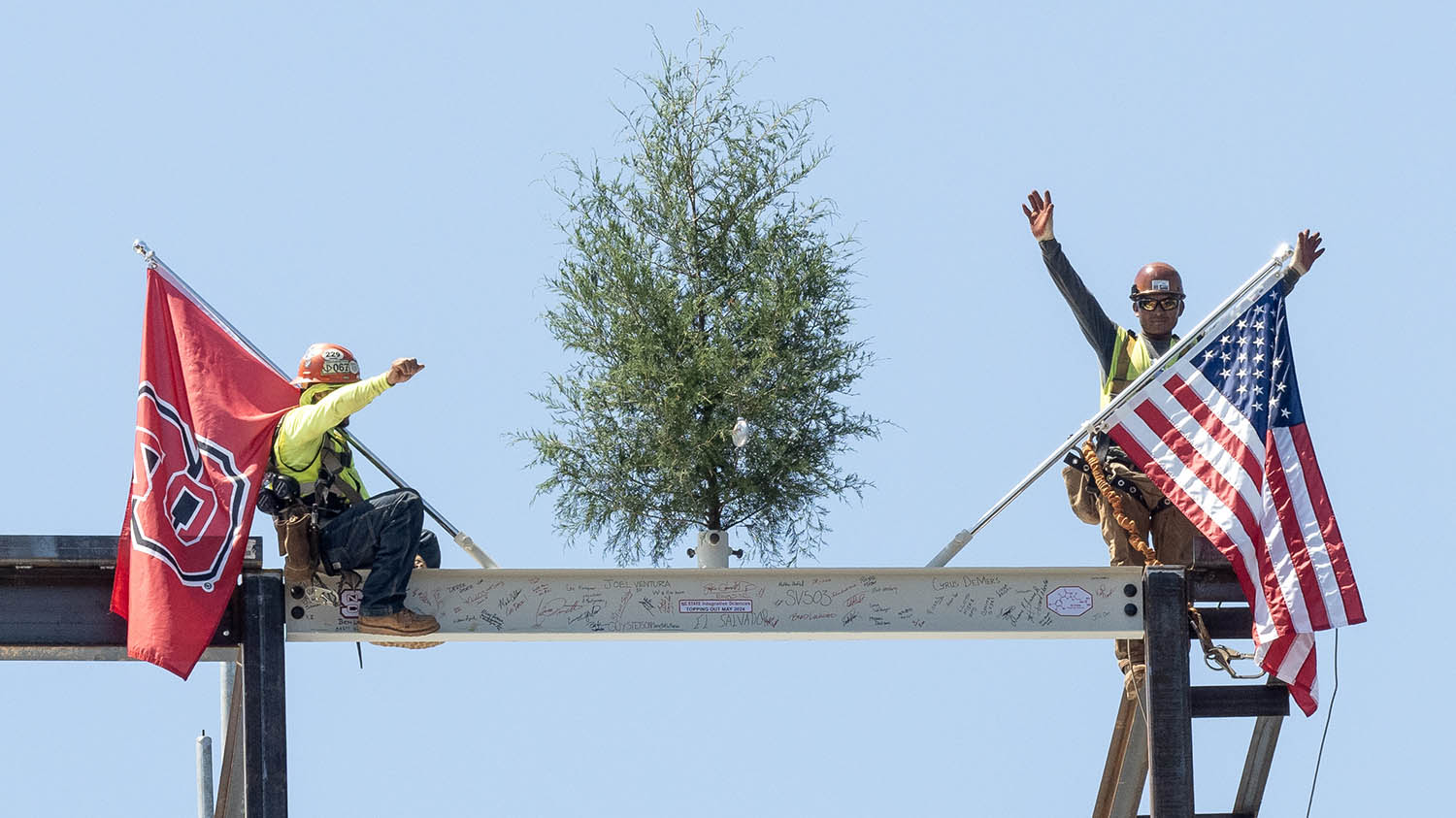
Ceremony Showcases Integrative Sciences Building’s Progress
- Skip to Primary navigation
- Skip to Main content
- Skip to Footer
Online banking
Personal banking
You are leaving HSBC.com. Please be aware that the external site policies, or those of another HSBC Group website, may differ from our website terms and conditions and privacy policy. The next site will open in a new browser window. Note: HSBC is not responsible for any content on third party sites, nor does a link suggest endorsement of those sites and/or their content.
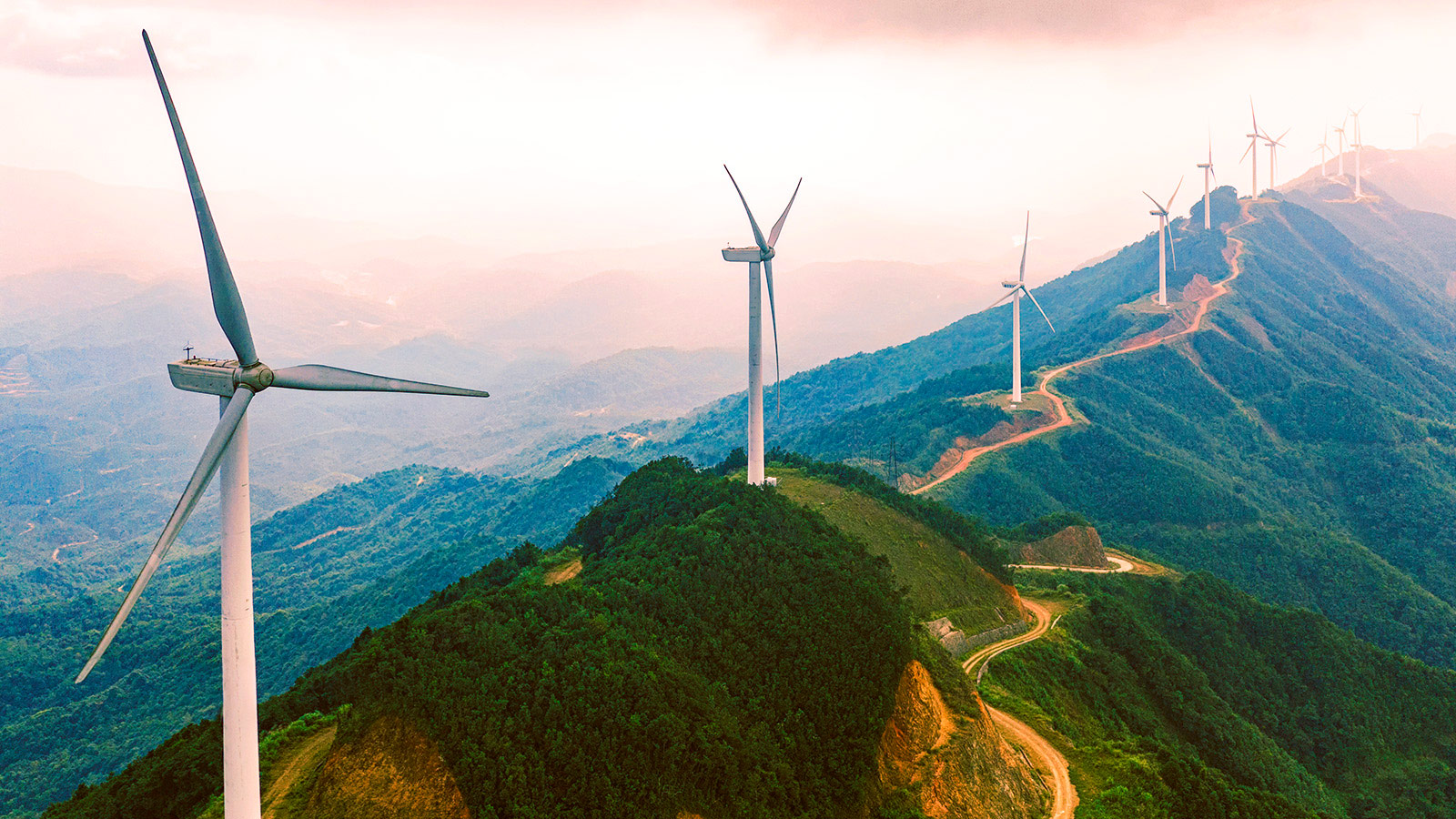
Our Net Zero Transition Plan
At a glance.
In October 2020 we set our ambition to become a net zero bank by 2050. Our first Net Zero Transition Plan provides an overview of our approach to net zero and the actions we are taking to help meet our ambition. It sets out:
Our vision and strategic approach – how we intend to use our strengths to make financing, facilitation and investment choices that can have a meaningful impact on decarbonisation in the real economy.
Our approach to sector transitions – we look at the expected transition in key economic sectors and how we intend to use sector pathways to engage with clients on the future of their industries and their financing needs. We also describe our approach to setting and evolving our sectoral financed emissions targets and making progress towards them.
Our implementation plan – how we are transforming HSBC, including how we support our clients and customers, embed net zero into our business, and partner for systemic change.
Our first Net Zero Transition Plan is an important milestone in the journey to achieving our net zero ambition.
Ambition to be a net zero bank by 2050, including in our portfolio of financed emissions, set on-balance sheet financed emissions targets to 2030 for key carbon intensive sectors, aim to provide $750 billion – $1 trillion in sustainable finance and investment by 2030.

“As one of the world’s largest international banks, HSBC is well placed to help support and finance the economic transformation required to reach net zero.”
Noel Quinn , Group Chief Executive, HSBC
Our approach to net zero
In 2020 we set an ambition to align our financing portfolio to net zero by 2050 and to achieve net zero in our operations and supply chain by 2030.
Our Net Zero Transition Plan brings together, for the first time, the steps we intend to take to deliver this. We also want to demonstrate how we intend to harness our strengths and capabilities in the areas where we believe we can best support large-scale emissions reductions.

Our motivation to act
- To seize the significant economic opportunity that exists in financing the investment needs of our clients and customers in the transition, while helping them to prosper.
- To help mitigate the rising financial and wider societal risks associated with failing to achieve the required transition across industries and geographies.
- To help shape (not just follow) the understanding, policies, market structures and standards necessary to achieve a just transition while maintaining sound economies.
Our role in the transition
Our starting point in the transition to net zero is one of a heavy financed emissions footprint. We will have a complex transition, with markets and sectors at different starting points and moving at different speeds. However, it also provides us with an opportunity to work with our clients and customers to help make an impact – in both the emissions challenge and the financing challenge.
We want to make financing choices that can lead to a meaningful impact on emissions reduction in the real economy, not just in our portfolio. Achieving this requires engagement with our clients and customers on their transitions to help finance decarbonisation in the sectors and regions with the most change ahead.
As we’ve supported much of the world’s industrial base for more than 155 years, we can play a prominent role in this transition.
We believe we can do this best by promoting change in three key areas that play to our strengths as an organisation and can help deliver a broader impact on decarbonisation in the real economy: transitioning industry, catalysing the new economy, and decarbonising trade and global supply chains.

“We are present in the regions, the markets and the sectors that arguably make the biggest impact in terms of future emissions. We have an opportunity to support them to make the transition and catalyse the new economy, following the science and leveraging our entrepreneurial spirit.”
Celine Herweijer , Group Chief Sustainability Officer, HSBC
Critical to our approach is a recognition that as a bank we cannot do this alone. Our ability to transition relies on decarbonisation in the real economy – both the supply and demand side – happening at the necessary pace.
Our clients and customers, and the industries and markets we serve will need to transition effectively, supported by strong government policies and regulation, and substantially scaled investment. Engagement and collaboration are therefore key to how we respond.
Our net zero principles
Science-based, transparent and accountable, integrating nature, just and inclusive.

Our approach to sector transitions
In our Net Zero Transition Plan, we have set out the key changes that, based on our current understanding, are required for the transition to net zero in key sectors of the global economy.
We expect to regularly review our sector portfolio progress against progress in the real economy, and to iterate and mature our approach to supporting sector transitions over time. As part of this, we expect to continue to review our approach to financed emissions analysis, targets, and portfolio alignment, as well as supporting clients and customers with transition plan engagement, innovating on transition solutions, and working with wider stakeholders to help support systemic change.
Our approach to implementation
To deliver on our ambition to be net zero by 2050 and have a meaningful impact in the real economy, we are setting out our implementation plan to embed net zero across key areas of our business.
Supporting our customers
Embedding net zero into the way we operate, partnering for systemic change.
Embedding net zero across our business covers areas including the products and services we provide, managing risk, using policies to drive change, our governance and incentives, our culture and capabilities and how we measure progress.

Understanding our transition plan
Our initial transition plan provides an overview of the progress we have made to date and what we plan to do next. We know there is still much more to do. We’re focusing our efforts on where we can help drive material and implementable change, and applying learnings as we work to embed net zero across HSBC.
The most significant challenge in developing a transition plan at this early stage is the relative novelty of the process and the uncertainty in many areas we are seeking to address. The only certainty is that these and other developing areas will unfold in ways that we cannot accurately forecast today.
As a result, the ambition and details around implementation in this transition plan will need to evolve over time.
Rather than wait for these areas to become clear we have chosen to lay out and pursue the plans we have today, based on currently available data, infrastructure, resources, technologies and standards.
Our transition plan will form the basis of further work on our journey to net zero over time, and we expect to review and update it periodically.
Downloads and further resources
Net zero transition plan.
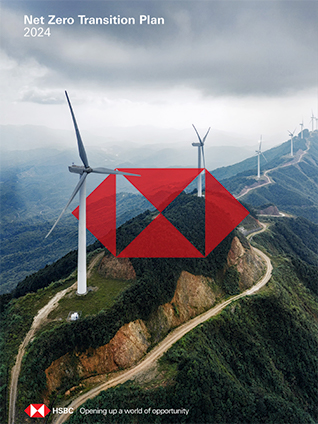
Further reading
- Our climate strategy
- Financing net zero
- Tracking the emissions we finance
- ESG reporting centre
- Email a link to this page
- Share on X Open in new window
- Share on LinkedIn Open in new window
- Share on Facebook Open in new window
- Share on Facebook Messenger Open in new window
- Share on WhatsApp Open in new window
- Email Email a link to this page
- X Share on X Open in new window
- LinkedIn Share on LinkedIn Open in new window
- Facebook Share on Facebook Open in new window
- Facebook Messenger Share on Facebook Messenger Open in new window
- Whatsapp Share on WhatsApp Open in new window
- Print Print this page
- RSS Subscribe to RSS
Did you find this page useful?
Why didn't you find this page useful.
- Poorly written
- Lacks detail
- Too complex
Thank you. We appreciate you taking the time to give us feedback.
Download basket
DISCOVER THE INNOVATIVE WORK WE ARE DOING ON:
- Air, Food & Water
- Art & Culture
- Cities & Towns
- Climate Change
- Energy & Technology
- Environmental Justice
- Law & Policy
- Nature & Conservation
- Sustainable Business

The Promise of Cameroon
air, food & water, climate change, nature & conservation
UCLA’s Congo Basin Institute is out to definitively map the African rainforests, a mission that could revolutionize climate science — and just maybe save the planet.
The African tribal leader gazed in open bemusement at the UCLA professor. It was the early 1980s, and the academic had pitched his tent on a mosquito-clouded bank of a river, deep in the Cameroonian bush.
“So, let me get this straight, Tom,” the village chief said. “You have a nice home in America. And a lovely family. And a car, and other stuff anyone else might want. And you choose to live … like this. Why?”
It’s a question that has crossed the mind of Thomas Smith many, many times over the past 40 years, as he’s sweated through bouts of malaria and a parasitical worm infection in his eye too disturbing to be recounted. His answer is simple: This is where Smith — who wears many UCLA hats in environmental science and biology, but who prefers a battered Bruin baseball cap in the field — feels he does his best work.
That work began, oddly enough, with an interest in a Cameroonian bird. Fascinated by a red-headed finch called the black-bellied seedcracker, a favorite study for followers of Darwin for its local beak varieties, the gregarious academic came to Africa in 1983 to study it. He soon found himself involved in wider environmental, political and human rights issues.
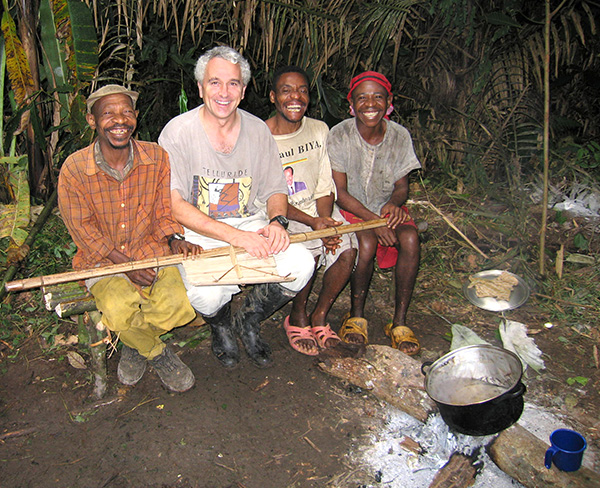
Over the decades, Smith has built productive relationships with scientists along the 3,000-mile Congo River, learning how to inspire and train African-born scientists to protect their environment. In 2015, he founded the Congo Basin Institute (CBI), the first such foreign affiliate in UCLA history. In a dramatic change from the days when scientists would basically parachute in, pursue narrow research and go home to publish, with little engagement with local scholars, CBI builds long-term professional relationships with Africans on the ground.
While Smith’s connections are spread across the continent, he has always found himself called back to Cameroon. “This is where I work with people protecting their families,” he says, “and the world.”
Cow Hooves, Peanuts and Toothbrushes
Yaoundé, Cameroon’s capital, is the very definition of African vibrancy.
It’s my first time in Africa in two decades, and I find myself overwhelmed not so much by the airport paperwork or the swampy humidity, but rather by the brutal tsunami of traffic. I know it’s a mark of prosperity of some kind, but the old city was not built for so many cars. Streets are choked and sidewalks pitted, maybe beyond repair. And it is so, so loud. I stand at an intersection and count more than 200 car horn blasts a minute, typically from oil-smoking, groaning Toyota Yaris taxis dragging their tailpipes along the ground.

Hawkers sell cow hooves, fresh peanuts and toothbrushes, all from baskets balanced confidently on their heads, mobile convenience stores weaving in and out of the foot traffic. One proffers a single gleaming white sneaker. “I will deliver the other shoe to your hotel tonight,” he says, “if you pay now.” Yaoundé’s citizens are trés chic: businessmen sport fashionably narrow black suits, mothers swirl in pink and green taffeta, high schoolers dazzle in orange and blue.
Cameroon is a California-sized, largely Francophone nation of 27 million people and 250 languages, situated just north of the equator in western Central Africa. It’s a place of great cats and gorillas and elephants, although most people never see any of them; the animal population is shrinking, and more and more Cameroonians are now urban. The cities thrive, exuberantly. There is a healthy middle class of college-educated researchers and academics. Yet, too often, African scientists are unable to travel to Global North academic conferences due to cost and visa issues. So the CBI comes to them.
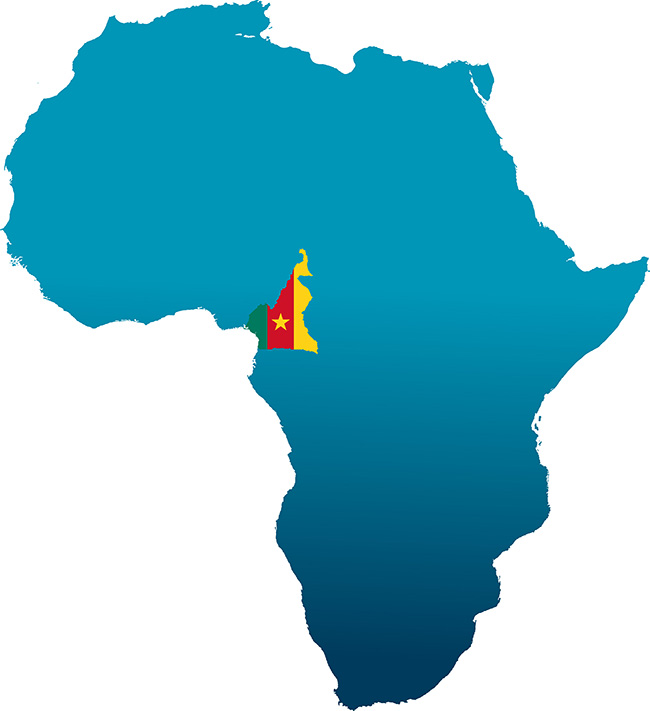
Cameroon lies at the juncture of western and central Africa. It boasts one of the most urban populations on the continent.
In his work for the CBI, Smith has enjoyed good days, such as when he and colleagues worked out a new way of balancing out the need to protect a virgin forest and to feed people from that same forest. There have also been terrible days. The idyllic beach resort of Kribi once produced extraordinary seafood; its roasted fish was famous. Smith was proud of the bird-monitoring field station he helped set up behind the sands, managed by local families, personally escorting foreign visitors there to appreciate the good work. Then, in 2017, Chinese engineers abruptly swept it all away to build a deepwater port. (They’re still selling off ancient forest land for housing.)
Right now, the most immediate challenge is to understand the overarching big picture, how all the moving parts of the ecologies of Cameroon and its neighbors along the Congo River fit together. Answering this question will help scientists plot a course that could help save humankind from looming climate disaster. Which is why, earlier this year, CBI’s new leaders flew 8,200 miles to Cameroon to meet with local scientists. And for the first time, their number did not include Tom Smith.
Introducing … PANGEA
On a sweet-scented day in February, more than a hundred African scientists, engineers and civil servants have assembled amidst the once-fashionable glory of Hotel Mont Fébé, on the lush outskirts of Yaoundé. It’s an extraordinary meeting of minds, hopes and ambitions. You can feel the excitement, the belief that change is possible. Change is also occurring at the CBI.
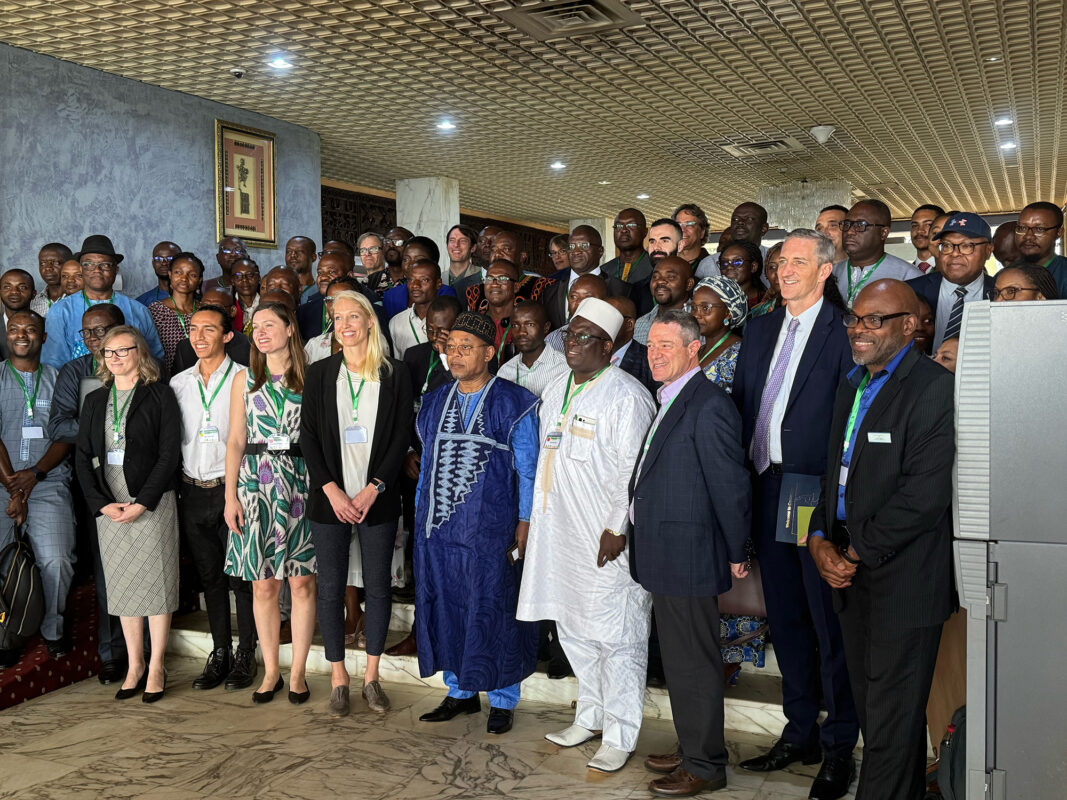
Smith remains as enthusiastic as ever, his famed battle cry “Go do it!” still fundamental to the institute’s thinking. But by not attending the meeting in Yaoundé, he is signaling his intent to hand over the reins to two recently appointed co-directors within UCLA: Colombian-born Felipe Zapata, who specializes in Latin American forestry, and Brooklyn-born Elsa Ordway, who a decade ago worked briefly with Smith in Africa. Zapata is an associate professor and Ordway an assistant professor within the UCLA Institute of the Environment & Sustainability (IoES).
Smith has stayed away with a touch of reluctance: “There are always friends to see and science to do. But I am excited to see Elsa and her team [including managing director Virginia Zaunbrecher, a corporate lawyer turned eco-warrior, and associate adjunct professor and biologist Kevin Njabo] carry the torch forward as they unveil PANGEA,” he says.
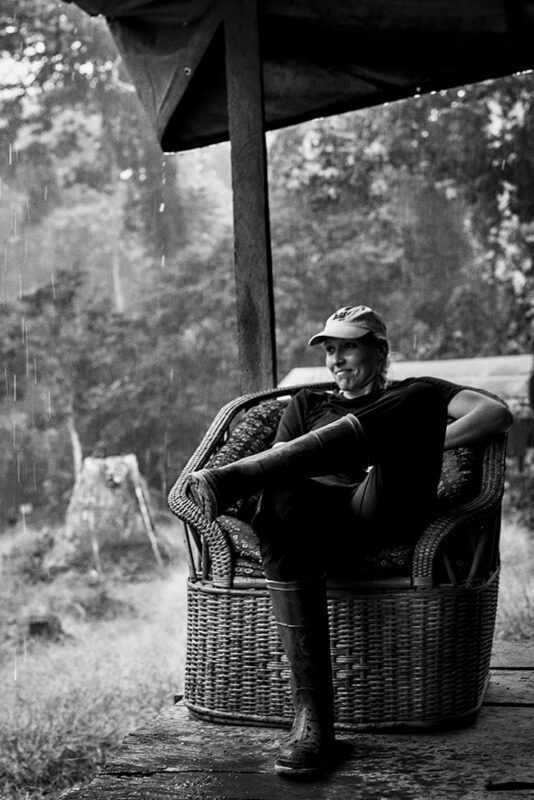
PANGEA is an audacious, 10-year plan to map the Congo River’s massive rain forest system, photographing and sampling its landscapes from forest floor to mountain top. Efforts led by UCLA researchers and funded by NASA will help lay the guidelines for work that will employ satellites, drones and an army of researchers on the ground. The project takes its name from the Pangea “supercontinent” that existed some 200 million years ago, the last global mass to unite the planet. The name encapsulates what UCLA is setting out to do in Cameroon: to remind us that we are all still tightly connected.
Over two days, Ordway and partners from NASA and the USDA Forest Service reveal the massive scope of PANGEA to scientists from around Africa, all potential colleagues in the grandest NASA-funded project so far this century.
Scientists sit in circles to outline the work: There will be field stations across the belt of the continent, some with 50-foot-high weather-monitoring towers, a reliable way of sharing data. Good science starts with counting things, and PANGEA researchers want to know how the 10-nation-spanning Congo River Basin works as a “carbon sink,” absorbing carbon dioxide; how the region is changing as a source of food for millions, most of them young; and how much forest can be turned over to agriculture before it fails as a carbon sink — and we all choke.
As an ecological system, the Congo Basin is far less understood than the planet’s other large carbon sinks — Amazonia, which was mapped by NASA satellites in the 1990s, and the forests of Southeast Asia. PANGEA will create the region’s first detailed maps, which will allow scientists to fully take stock of environmental change in this vital region of the world.
For Ordway, working out how such knowledge can be practically applied by Africans to improve African lives is the true promise behind PANGEA.
There is, however, a big “if.”
Over the next few months, Ordway and her new colleagues from the conference will create a set of proposals to be reviewed by NASA’s climate scientists at the Jet Propulsion Laboratory in Pasadena. If the proposals are selected, there could be money to launch PANGEA in the future. If further funding doesn’t materialize, Ordway says cheerfully, there are still dozens of collaborative projects to be funded individually and fleshed out over many years. “It will be slower,” she says, “but it has to happen.”
A lifetime’s work ahead with PANGEA isn’t what Ordway expected as an undergraduate juggling environmental science and African studies. But, as she took a year away from study to work in the Comoros and Madagascar, she was smitten with the African people.
“I fell in love with the community life, with the children in classrooms where I taught,” she says. “But I realized, after working with sea turtles in Equatorial Guinea, that my practical skills were inadequate. I came back from Africa to the States to learn more. This led to teaching. I did not intend to stay in academia, but I found my place at UCLA. And now, with PANGEA, I think UCLA and CBI can make a real difference.”
Tall and blonde, Ordway stands out in Yaoundé. She is patient in a local bar that declines to serve women beer or even allow them to carry their own drinks up some slight stairs. That’s all a distraction, and Ordway knows she cannot afford any.
“You listen, you learn and you go where people live to see the world from their perspective,” she says, “which is the CBI mission.”
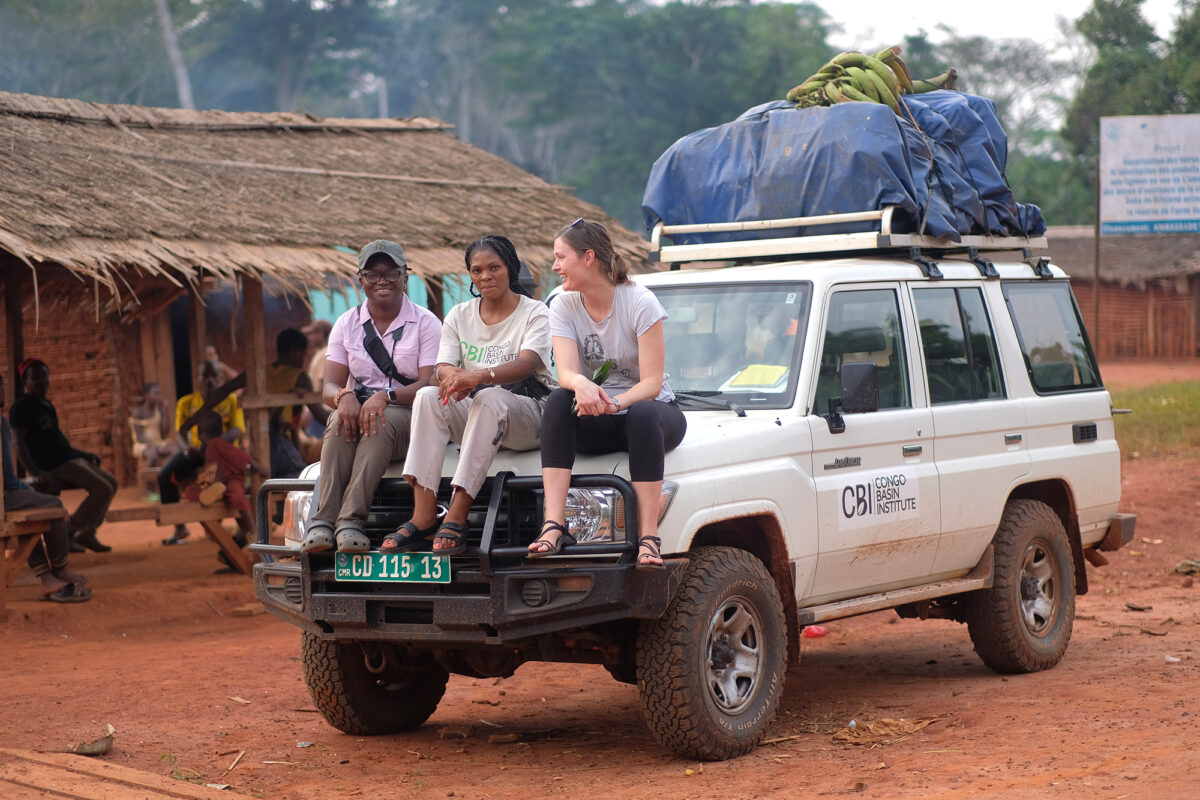
Into the Woods
I’m riding in a CBI-marked SUV, heading east past vivid street markets and police roadblocks, when we overtake a water tanker at 40 mph. There are three young bulls tethered to its roof. “How do they get up and down?” I ask, bewildered. No one seems sure.
It takes three hours of driving along a busy two-lane highway, through smoke clouds from randomly burning clumps of roadside trees, before we abruptly turn south onto a red dirt road. Another two hours of swerving around potholes, and we arrive at the edge of the Dja Faunal Reserve.
This is a UNESCO World Heritage site, 1.3 million acres of dense forest — larger than the state of Rhode Island — and home to western lowland gorillas, buffaloes and leopards.
CBI has two field stations here. Neither are as basic as Smith’s original encampment, but this is hardly safari tourism. We overnight in a bungalow in the hamlet of Somalomo, at the edge of the reserve.
A Baka family in front of a traditional hut; their child suffers from kwashiorkor (swelling of the stomach), a severe form of protein malnutrition that affects children and infants.
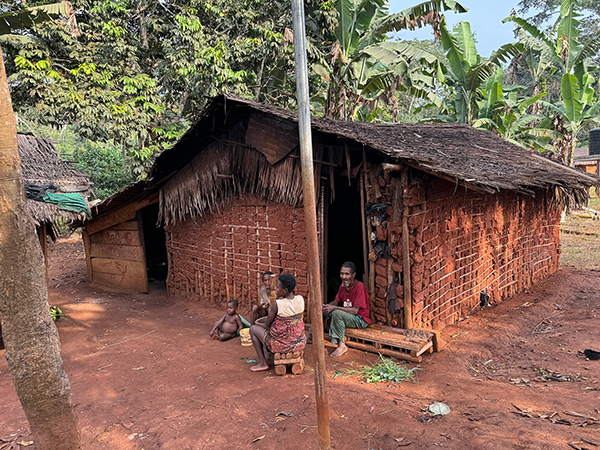
The field station is a workplace but feels like a jolly youth hostel, offering tepid water, dormitory mosquito nets, a self-flushed toilet setup and a very handsome oil portrait of Smith (a gift from a local artist). Whiskey is poured; we dutifully toast the painting before the scientists hunker down to work.
Such humid nights can be busy. Chimpanzees rarely come by Somalomo anymore, but at 3 a.m., fruit bats swoop and tiny goats crash about. (I’m warned: They’ll eat your shoes. ) The most boisterous denizen is the tree hyrax, which looks like a squirrel but is related to the elephant; its ever-escalating cries are described by locals as “orgasmic.” Rappers have mixed the hyrax’s calls into 1970s recordings of saxophonist Manu Dibango to play at funeral parties.
Smith opened the Somalomo research base in 1993 as he grew closer to the Baka, the local forest nomads. They helped him understand how the ecosystem works — what to eat, what works as medicine, which plants and animals are vanishing fast. The truth is, all of them are.
Today, around 30,000 Baka live in square straw-roofed huts in communities strung along the dirt roads inside and beyond the reserve.
They face tough health and nutritional challenges that disproportionately impact young people. UCLA Fielding’s Kevin Njabo, who grew up in Cameroon, worries that imported anti-vaccine sentiment may intensify the struggle to protect children.
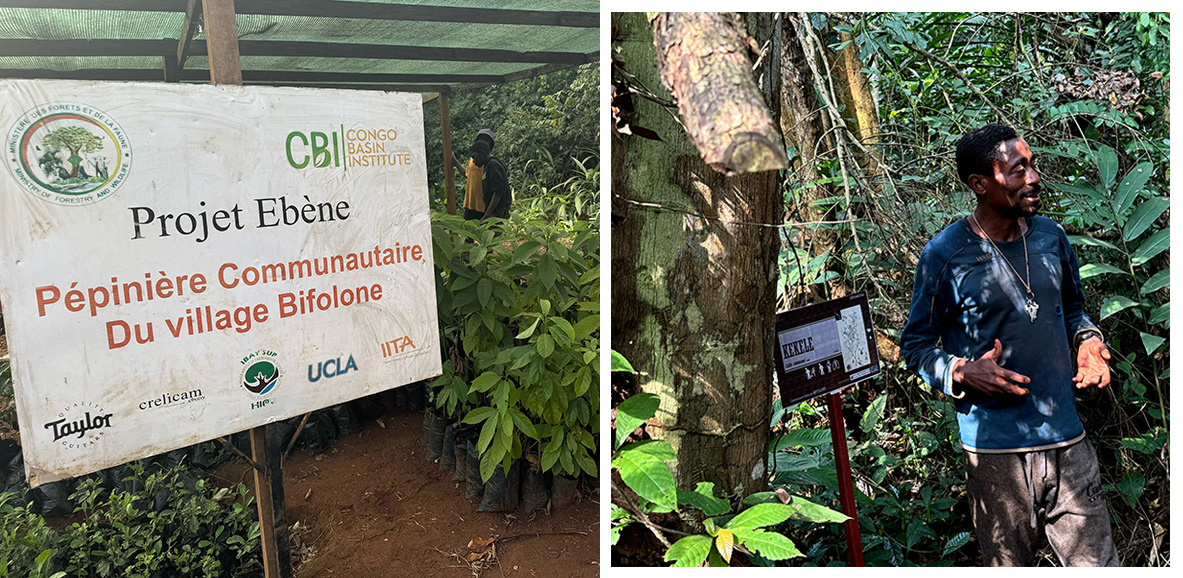
Right now, the Baka do not listen to such silliness. They relish interacting with foreigners, share their jokes, argue about soccer — there are a surprising number of Liverpool FC fans — and hope for a prosperous future for their families.
Some Baka are working on CBI’s Ebony Project, a program to replant precious hardwood trees that were plundered wholesale from forests decades ago.
The project, co-funded with Taylor Guitars of San Diego, will plant 30,000 ebony trees before 2025, as well as thousands more fruit trees. Luckily, says CBI researcher Vincent Deblauwe, the ebony matures relatively fast — maybe in 60 rather than 100 years. Some trees sell for $20,000, making them a great investment for building the local economy long term.
Near the roadside village of Bifolone, the Baka nurture ebony in nurseries near their own medicinal trees. Apart from other traditional cures the trees offer, Gaston, a Baka elder, says the stewed bark will also “send off” impotence. It must work — the villages are filled with noisy toddlers.
Take a stunning photographic journey through the life of the Baka.
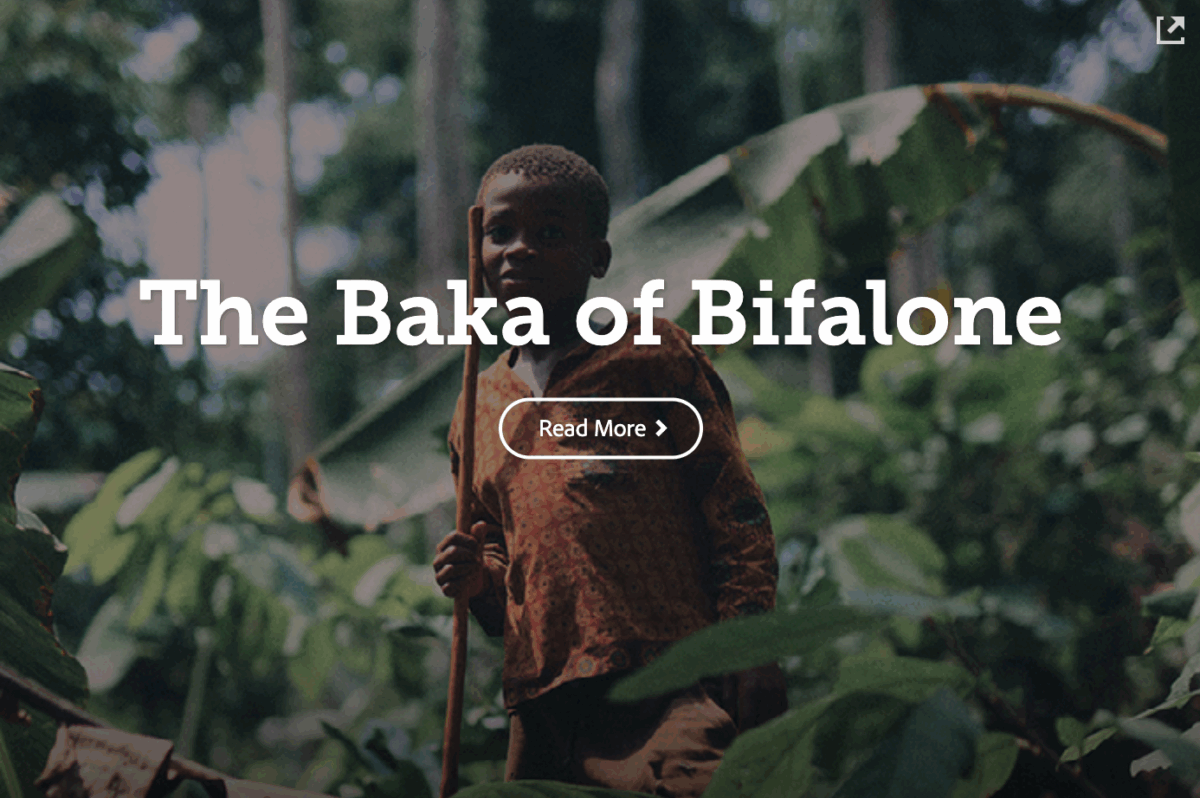
The Gift of (Local) Knowledge
The nine-hour (yes, nine-hour) hike from Somalomo through the forest reserve to the second CBI field station, Bouamir, is not for the weak-ankled. But the path through the cool green canopy is straight, flat and — with an armed guard to deter any unwelcome distractions, be they animal or human — relatively safe.
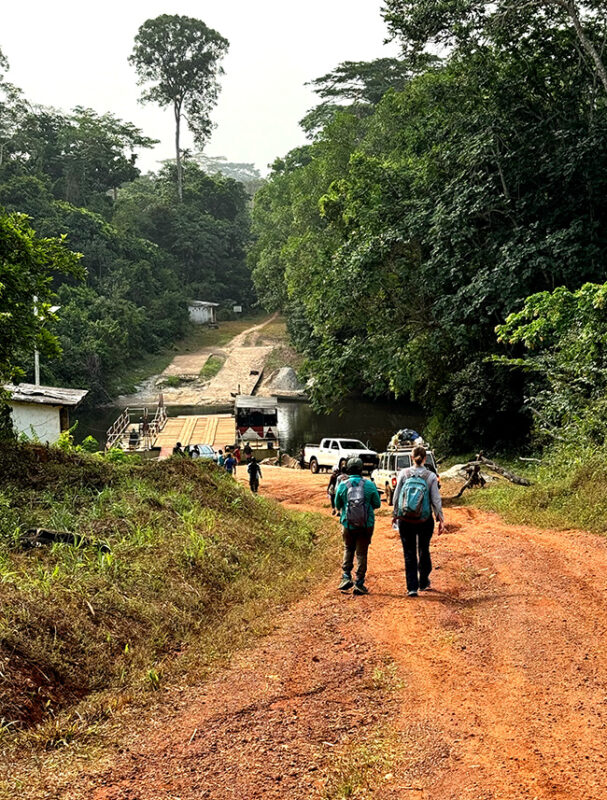
We cross a swirling brown river on a hand-cranked ferry to reach the trailhead. The crew gets busy stripping the truck of food and other essentials to be carried into the forest.
A few hours in, the hiking party grows quiet. Some seem to fall into a semihypnotic trance as they walk, while the hard-core scientists in the group note tiny changes in the fauna and flora since their last trek. The forest is always changing, says the Belgium-born Deblauwe, a postdoctoral researcher within IoES, but he says it’s grown noticeably quieter as animals and birds have disappeared.
The research platforms in the middle of the reserve are just that: open wooden structures hemmed in with mosquito nets. But the potential to carry out research in such an understudied area is catnip for climate and environmental scientists. Baka are working constantly at Bouamir on botanical and other counts, so data are always being updated. And a bonus: fewer goats. Here, it’s largely bugs, birds and monkeys greeting you in the morning.
The Baka knowledge is deep, says Iroro Tanshi, a mammal expert and winner of the 2023 UCLA Pritzker Prize’s Emerging Genius Award, bestowed annually to a global environmental innovator under age 40 who is doing exceptional work. When Tanshi, a determined and passionate advocate for the underappreciated bat, asks locals about bat populations, she usually hears about a handful of species. At Bouamir, to her delight, Baka tell her about 15 species, sketching each out in detail.
“The Baka really appreciate the creatures around them,” she marvels. “They are observant and understanding, and although I am familiar with forest and jungle, it’s well worth the trek into an extraordinary world.”
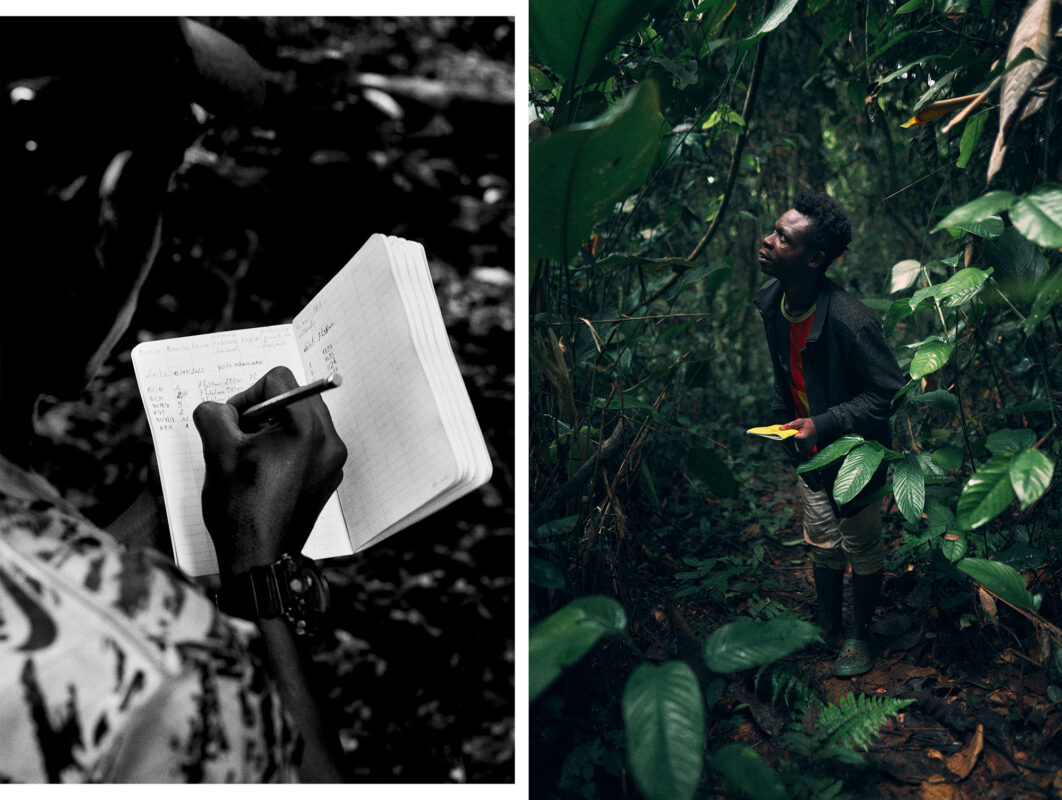
For the People and the Planet — and Tom
There is one thing, apart from science, that keeps bringing CBI leadership back to Cameroon. “It’s always the people,” says Smith.
As he steps away from a leadership role, he is hopeful about new CBI prospects such as UCLA Ph.D. candidate Hannah Stouter, an upstate New Yorker on her first trip to Africa to study climate change under Ordway. “I am just amazed by everything,” Stouter says, wide-eyed. “CBI does extraordinary work in a new way, and I want to be part of that.”
Like Stouter, CBI is looking to the future. Depending on how the funding plays out, PANGEA will either be rolled out wholesale from 2025 or in chapters over the next few years, with the potential to change our understanding of the world. The knowledge CBI and its partners collect will likely confirm Smith’s once-radical belief that the Congo Basin is a vital element of the world ecosystem. As Ordway says: Understand it, learn how to protect it and work with Africans — or risk losing the whole game for humanity.
CBI is thinking global, but it already boasts a proud legacy in Cameroon. A few miles north of Somaloma is a gendarme outpost where police check ID papers. In the yard is a mature tree known as the Tom Smith Mango.
Whether Smith actually had anything to do with its germination remains unclear. But today it offers fruit and shade to passersby, who appreciate it with the moniker that honors both CBI and UCLA. As they pick the mangoes, the Baka say, “Joku, bella, bella, Tom.”
Thank you, Tom. Good job, good job.
Photos by Clayton Boyd
Read more from UCLA Magazine ’s Summer 2024 issue .
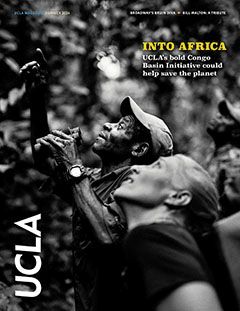
MEET THE AUTHOR
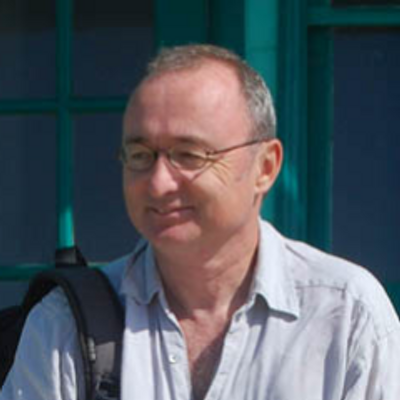
John Harlow
RELATED ARTICLES
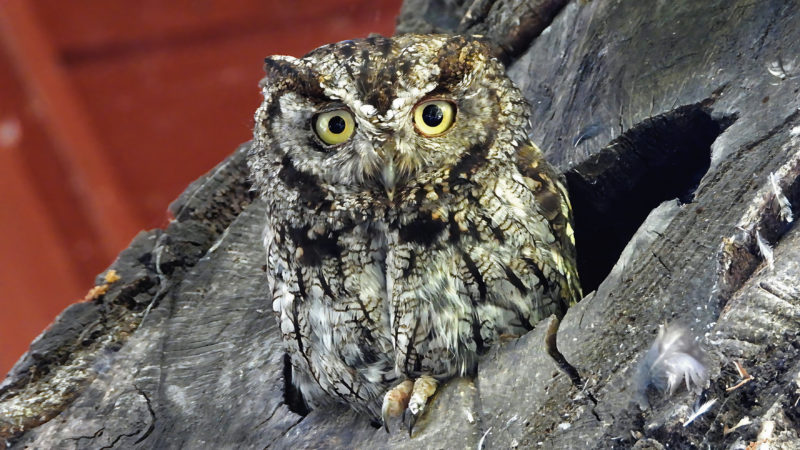
UCLA seniors study L.A. owl habitats with Friends of Griffith Park

UCLA storytellers use Grand Theft Auto as basis for series of original films imagining L.A. in 2050
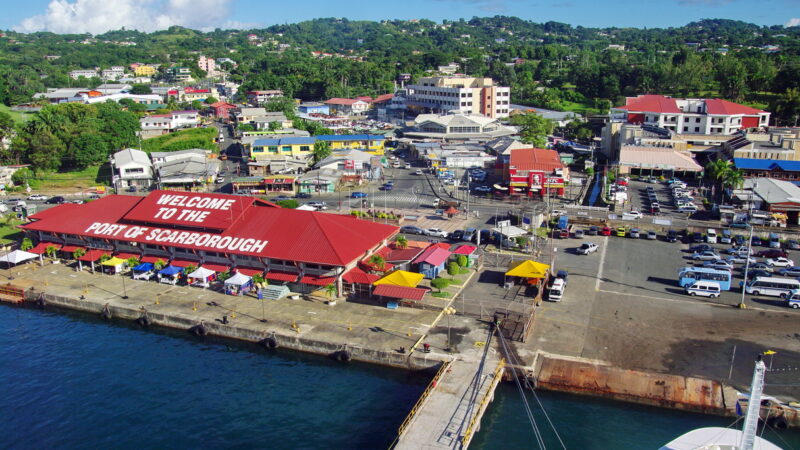
UCLA seniors model flood vulnerability in Tobago

IMAGES
VIDEO
COMMENTS
Journey 2050 is a school program that uses online, global, guest speaker and field trip options to teach students about the challenges and solutions of feeding the world. Learn how to create a plan to make a difference in your community and explore the curriculum updates and news.
Play Farming Games Online - Journey 2050. Home Play The Game. Feeding the World in 2050. Now is your chance to virtually farm! Remember to monitor your soil and water health and make investments to improve your sustainability barrel. Play Online or Download the Game ; Open the game right from your web browser:
Journey 2050 is a self-guided online program that teaches students about agriculture and food sustainability. It challenges them to grow more food for a growing population by 2050.
Play the game and virtually farm in 2050, a future where food security is a challenge. Learn how to monitor and improve your soil and water health and sustainability barrel.
Journey 2050 is a free online program that challenges students to feed nearly 10 billion people by 2050. It features interactive games, global events, and real farmers from around the world.
Journey 2050 is a curriculum-based program that explores the challenges and opportunities of feeding the world in 2050. It offers three experiences: Online, Guest Speaker and Field Trip, with curriculum links, videos, games and activities.
The year 2050 is a key moment in time - the world's population will be a projected 10 billion. As a result, food production needs are expected to rise by 60-70% and changing agronomic conditions will place pressure on agricultural yields. Journey 2050 is a FREE agriculture education program that challenges participants to answer the ...
About this game. How will we sustainably feed 10 billion people by 2050? REAL FARM FAMILIES will guide you through your journey as you VIRTUALLY FARM in Kenya, India and Canada. The year 2050 is a key moment in time - the world's population is projected to be 2 billion more than today. Food production needs are expected to rise by at least 60% ...
If you enjoyed the Journey 2050 Sustainability Farming Game, download Farmers 2050! This game builds on the concepts introduced in the Journey 2050 program and adds real-life complexity. The National Agriculture in the Classroom website provides K-12 educators with engaging resources to increase agricultural literacy among their students.
The goal of Journey 2050 is to engage students in positive discussions about the importance of sustainable agriculture, best management practices and innovations. Feeding the world is the responsibility of all. We need to think about the ways we act now so that future generations and our natural environment may prosper. Food is life.
REAL FARM FAMILIES will guide you through your journey as you VIRTUALLY FARM in Kenya, India and Canada. The year 2050 is a key moment in time - the world's population is projected to be 2 billion more than today. Food production needs are expected to rise by at least 60% resulting in increased pressure on agricultural land, habitats and ...
Journey 2050. 1,099 likes · 81 were here. How will we sustainably feed nearly 10 billion people by 2050? LEARN about ag innovations, PLAY virtual farm simulations, SHARE your ideas & JOIN us on our...
Virtually farm with real farm families around the world in the Journey 2050 program. Can you sustainably feed a growing population by the year 2050? Check ou...
Land is one of our most vital resources. We will need to grow more food on the same amount of land (or less) by 2050, when the world's population is expected...
Journey 2050 takes students on a virtual simulation that explores world food sustainability. It is a free online program for Grades 7-12. Using an inquiry-based approach the program encourages students to make decisions and adjust them as they see their impact on society, the environment and the economy at the local and global scale. ...
Journey 2050 is a free educational experience for grades 4+, offered as a field trip or guest speaker opportunity. Teacher Testimonials "They all loved the game and wanted to download and keep playing! Very interactive and motivating for this generation. Thank you for the many direct ties to science 7 curriculum."
Journey 2050 allows schools to experience agriculture like it's never been taught before. As grade 7-12+ students explore sustainable agriculture they make inquiry-based decisions to see the ripple effect on social, economic and environmental factors locally and globally. Farm families from Kenya, India and Canada guide students through ...
Journey 2050 is a FREE agriculture education program that teaches students about different countries, careers and innovations that make agriculture one of the leading industries in the world.. Unlike any farming game you've ever played, Journey 2050 is based on real-life challenges and opportunities. Using an inquiry-based approach, this gamified, virtual program encourages students to make ...
This lesson has been adapted for online instruction and can be found on the Journey 2050 eLearning site. Open the Land Use slide deck. Begin by reminding students how many people are currently on planet Earth (7.6 billion in 2018) and that expert demographers are anticipating nearly 10 billion people by the year 2050 (www.Worldometers.info).
The Journey 2050 program was originally developed by Nutrien in collaboration with Calgary Stampede, Alberta Canola Producers Commission, Nutrients for Life Foundation, and Agriculture in the Classroom Canada. Authors and contributors were drawn from each of these organizations under the direction of Lindsey Verhaeghe (Nutrien) and Robyn Kurbel ...
Journey 2050 is a program that combines curriculum and an interactive online game to teach students about food sustainability on a local and global scale. Lessons provide a background and are easily adaptable to virtual learning scenarios. Check out the adapted elearning Journey 2050 lessons here!
Journey 2050 allows schools to experience agriculture like it's never been taught before. As Grade 7-12 students explore sustainable agriculture, they make inquiry-based decisions to see the ripple effect on social, economic and environmental factors. Farm families across the world guide students through interactive games such as a virtual ...
This video guides students through Lesson 3 of the Journey 2050 program. This lesson introduces students to water as a limited natural resource and introduce...
Tanzania is embarking on a transformative journey with its Vision 2050 initiative, designed to shape the nation's future development. Inspired by long-term planning traditions from the former ...
In this episode of Biotech 2050, host Alok Tayi, CEO and co-founder of Vibe Bio, speaks with Dr. Bruce Leuchter, President and CEO of Neurvati Neuroscience. They discuss capital markets, neurology, psychiatry, and Neurvati's work in ultra-rare diseases. Dr. Leuchter shares his journey from clinical training to leadership at Neurvati.
Jordan Kern models environmental risks, and Harrison Fell studies the economics of energy systems and policy. In November 2023, they shared what they know about what influences energy policies, how those policies play out in society, and why people behave the way they do. In our conversation, they laid out the challenges - and opportunities - that may arise on the journey to a green energy ...
In October 2020 we set our ambition to become a net zero bank by 2050. Our first Net Zero Transition Plan provides an overview of our approach to net zero and the actions we are taking to help meet our ambition. ... Our first Net Zero Transition Plan is an important milestone in the journey to achieving our net zero ambition. Ambition to be a ...
Smith remains as enthusiastic as ever, his famed battle cry "Go do it!" still fundamental to the institute's thinking. But by not attending the meeting in Yaoundé, he is signaling his intent to hand over the reins to two recently appointed co-directors within UCLA: Colombian-born Felipe Zapata, who specializes in Latin American forestry, and Brooklyn-born Elsa Ordway, who a decade ago ...